William Robertson Adam
Private, No. 911
4th Battalion, 1st Infantry Brigade, 1st Australian Division
Killed in action, 5 May 1917, Bullecourt, France
Buried Vraucourt Copse Cemetery, France
In Memory of the Dearly Loved Son of the Late Mr. & of Mrs. Adams Sydney
William Adam, as well as being the first name on the Drummoyne War Memorial, was one of the first men to enlist in the AIF. On 1 September 1914 while employed as a labourer at Garden Island, William enlisted in the AIF at Randwick. The son of the widowed Robina Adam of ‘Gowanbrae’, Broughton Street, Drummoyne, William was an ‘original’ seeing service at Gallipoli, in Egypt and eventually the Western Front in France. William was wounded on three occasions while on active service before being killed in action at the Second Battle of Bullecourt in May 1917. He is buried at Vraucourt Copse Cemetery, France.
Studio portrait of William Adam courtesy of John Adam.
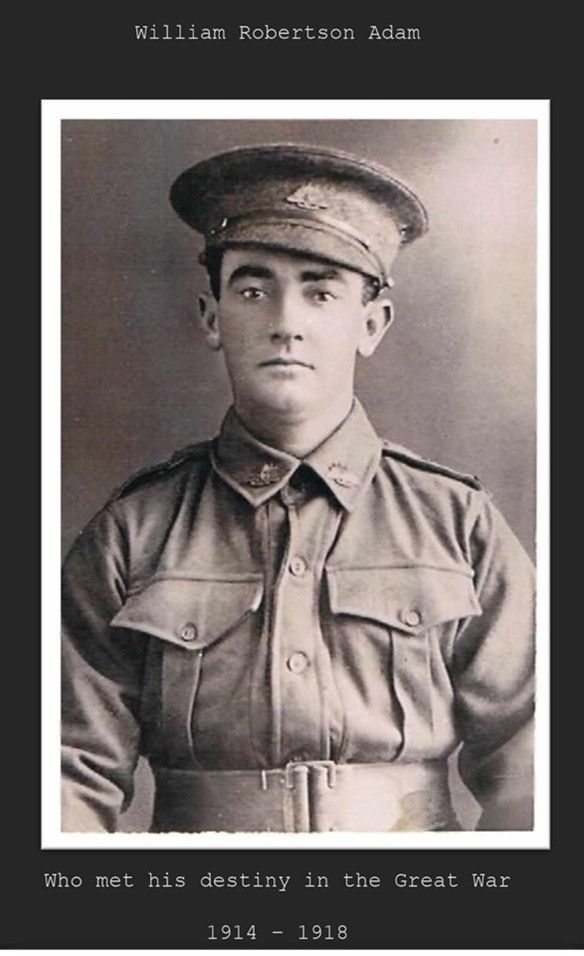
Thomas Chambers Ballantine
Private, No. 3314
13th Battalion. 4th Infantry Brigade, 4th Australian Division
Killed in action 10 August 1916, Mouquet Farm, France
No known grave. Commemorated at Australian National Memorial, Villers-Bretonneux, France
Thomas Ballantine was born in Brisbane in 1890 to John and Lettila Ballantine. By the time of his enlistment in the AIF on 23 August 1915, his parents had died and he was living with an aunt, Mrs Martha Johnstone, at ‘Rockton’, 35 Dening Street, Drummoyne. Within 12 months of his enlistment, Thomas was killed in action at Mouquet Farm. Thomas’ younger brother John Ballantine, serving in the 49th Battalion, would be killed in the same area the next month. Thomas’ service records indicate that he was buried near Mouquet Farm although his grave was lost in subsequent fighting. Thomas is commemorated at the Australian National Memorial, Villers-Bretonneux, France.

Rothwell Oliver Emil Barder
Lieutenant
20th Battalion, 5th Infantry Brigade, 2nd Australian Division
Killed in action 18 September 1916, Ypres, Belgium
Buried Lijssenthoek Military Cemetery, Provincie West-Vlaanderen - Flanders, Belgium
"Dearly Loved. Greatly Missed. In Certain Hope of the Resurrection"
Rothwell Oliver Emil Barder was born in 1890 in Victoria but moved to Huntleys Point with his family shortly thereafter. Rothwell was educated at Drummoyne Superior Public School and was an accomplished sportsman and an officer in the CMF. While employed as a storekeeper near Tumut, Rothwell enlisted in the AIF in October 1915 and was commissioned as an officer later that year. He was assigned as a reinforcement to the 20th Battalion as part of the 2nd Australian Division, and saw action in French Flanders, Pozières and Mouquet Farm. While serving in the frontlines outside Ypres, Rothwell was mortally wounded by a German shell and died at a casualty clearing station. Rothwell is buried at Lijssenthoek Military Cemetery, Belgium.
Photograph of Rothwell Barder – source
https://www.lijssenthoek.be/en/address/4919/-rothwell-oliver-barder.html
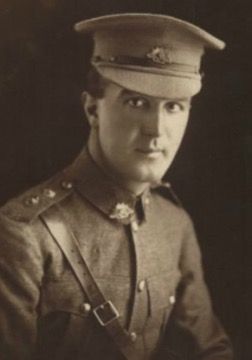
Harley James Baron
Sergeant, No. 2566
3rd Battalion, 1st Infantry Brigade, 1st Australian Division
Killed in action 2 September 1916, Hill 60, near Ypres, Belgium
Buried Larch Wood (Railway Cutting) Cemetery, Belgium
A Most Devoted Only Son Who Fully Justified His Manhood
Harley (Barles) James Baron was born in 1893. He attended school and was brought up in Drummoyne by his parents, who lived at 17 Broughton Street. Harley studied at various agricultural colleges and moved to Leeton where he was working as a farmer when he enlisted in June 1915. Harley briefly saw action during the last days of the Gallipoli campaign and survived the fighting at Pozières and Mouquet Farm. While his battalion was occupying trenches near Hill 60 south of Ypres, Belgium, Harley was killed in action possibly by a German sniper. He was 22 years old. Harley is buried at Larch Wood (Railway Cutting) Cemetery, Belgium.
Photograph of the headstone of the grave of Harley Baron at Larch Wood (Railway Cutting) Cemetery, Belgium.
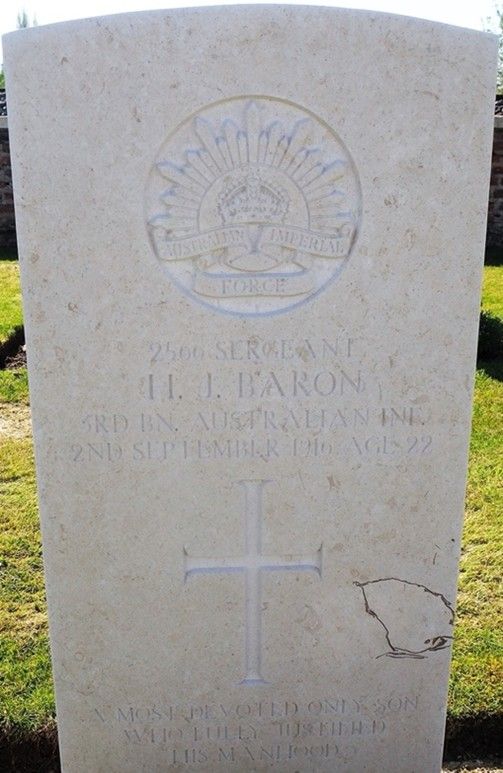
Albert Bates
Sergeant, No. 3004
55th Battalion, 14th Infantry Brigade, 5th Australian Division
Killed in action 2 September 1918, Peronne, France
Buried Heilly Station Cemetery, Mericourt-L’Abbe, France
Albert Bates was 19 years old when he enlisted in the AIF. A trade packer by occupation, he had attended Drummoyne Superior Public School and spent time in the Citizens Military Forces prior to enlistment. His parents, James Henry Bates and Mary Jane Bates, lived at 34 Renwick Street, Drummoyne but his father would pass away in 1916. Albert saw action at Fromelles, Flers and Ypres on the Western Front, and become an instructor with the 14th Training Battalion, spending time in the UK. He returned to his Battalion and saw further fighting in the late months of the war, including at Villers-Bretonneux and Peronne where he was struck by a shell and suffered a fatal head wound. Albert is buried at Heilly Station Cemetery, Mericourt-L’Abbe, France.
Photograph of the grave of Albert Bates, Heilly Station Cemetery, Mericourt-L’Abbe, France.
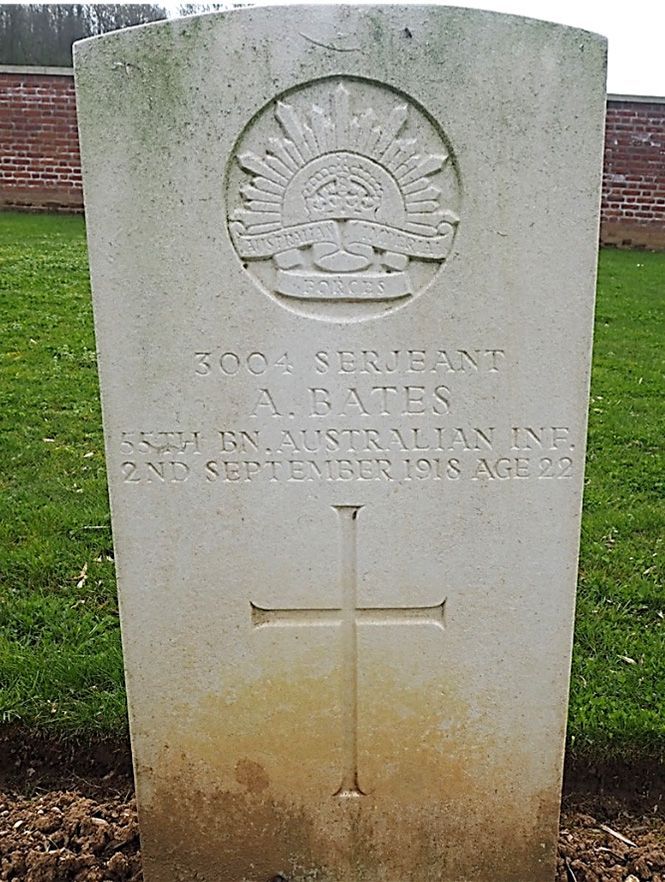
Albert Henry Boxall
Private, No. 1143
17th Battalion, 5th Infantry Brigade, 2nd Australian Division
Died of wounds 9 November 1916, Flers, France
Buried Heilly Station Cemetery, Mericourt-L’Abbe, France
Albert Boxall was born in England and had emigrated to Australia in about 1914. Married with two children at the time of his enlistment, the family lived at 36 Toxteth Road, Glebe. Albert joined the AIF on 17 February 1915, seeing action in in the last months of the Gallipoli campaign and on the Somme in France. Albert died from wounds received near Flers, France, on 9 November 1916 and is buried at Heilly Station Cemetery, Mericourt-L’Abbe, France.
Photograph of the headstone of the dual grave containing the remains of Albert Boxall at Heilly Station Cemetery, France.

Edward Francis Boyle
Lance Corporal, No. 2574
55th Battalion, 14th Brigade, 5th Australian Division
Killed in action 20 July 1916, Fromelles, France
Buried ANZAC Cemetery, Sailly-Sur-La-Lys, France
Edward Francis Boyle was 28 when he enlisted to join the AIF. He was the son of Edward Francis Boyle (Snr) and Sophia Lamberdina Boyle who lived at ‘Lamberdina,’ 18 Thornley Street, Drummoyne. Edward served briefly with the 55th Battalion and was killed in his and the battalion’s first action at Fromelles on 20 July 1916. Unlike many other Australians killed in this action, his body was recovered and he is buried at ANZAC Cemetery, Sailly-Sur-La-Lys, France.
Photograph of the headstone of Edward Boyle buried at ANZAC Cemetery (author, 2018).

Charles Frederick Henry (Harry) Bradhurst
Private, Nos. 820 and 2556
ANMEF and 18th Battalion, 5th Infantry Brigade, 2nd Australian Division
Killed in action 26 July 1916, Pozieres, France
No known grave. Commemorated at Australian National Memorial, Villers-Bretonneux, France
Charles Frederick Henry (Harry) Bradhurst was born in Terang, Victoria in 1896, the son of Francis (Frank) Symonds Bradhurst and Sara Louise Hewitt. He enlisted shortly after the outbreak of the war, when he was living in Balmain. Harry initially served with the ANMEF, before joining the 18th Battalion of the AIF. Harry was killed in action during the Battle of Pozieres on 26 July 1916, and his body was never recovered. He is commemorated at the Australian National Memorial at Villers-Bretonneux.
Augustus Charles Brander
Private, No.6951
3rd Battalion, 1st Infantry Brigade, 1st Australian Division
Died of illness 16 February 1917, England
Buried Durrington Cemetery, Wiltshire, UK
"He Hath Done … (What He Could)"
Augustus (Gus) Charles Brander was 29 years old when he enlisted in the AIF in October 1916. Gus was allocated as a reinforcement for 3rd Battalion but did not see any action nor join his unit. Gus contracted pneumonia while stationed at the Australian military base at Salisbury. He died on 17 February 1917 and was buried close to the base at Durrington Cemetery.
Portrait of Augustus Charles Brander – source
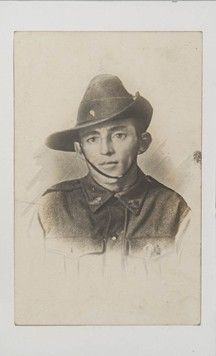
Hugh Breckenridge
Lieutenant
19th Battalion, 5th Infantry Brigade, 2nd Australian Division
Killed in action 3 May 1917, Bullecourt, France
Buried Queant Road Cemetery, Buissy, France
IN LOVING MEMORY FROM HIS WIFE DORIS
Hugh Breckenridge came from a large and well-known family in Drummoyne, who operated a timber merchant business at Birkenhead. Married to Doris Ricketts at about the time of the outbreak of the First World War, Hugh enlisted in the AIF in February 1916 and was commissioned as a second lieutenant with the 19th Battalion as part of the 2nd Australian Division. Hugh was killed in action at Bullecourt, France, in May 1917 less than a week after joining his battalion. Hugh is buried at Queant Road Cemetery, Buissy, France.
Headstone of the grave of Hugh Breckenridge at Queant Road British Cemetery, France.

Dick George Briggs
Private, No. 4627
3rd Battalion, 1st Infantry Brigade, 1st Australian Division
Killed in action 9 April 1917, Hermies, France
Buried Beaumetz Cross Roads Cemetery, Beaumetz-les-Cambrai, France
Their Glory Shall Not Be Blotted Out
Dick Briggs enlisted in the AIF on 16 June 1916 when he was about 25 years old. At the time of his enlistment, his parents, Walter and Kate Briggs, lived at ‘Ossett’, 295 Bridge Street, Drummoyne. Dick joined the 3rd Battalion and saw action on the Western Front at Pozières where he was wounded. After a period of convalescence in England, Dick rejoined his battalion and saw further action as part of the attacks on the Hindenburg Line. Dick was killed in action on 9 April 1917 near Hermies and was initially buried in an isolated grave close to where he had been killed. After the war ended, his remains along with others were exhumed and re-interred in Beaumetz Cross Roads Cemetery.
Photograph of Dick Briggs. Source - Europeana 1914-1918 Source
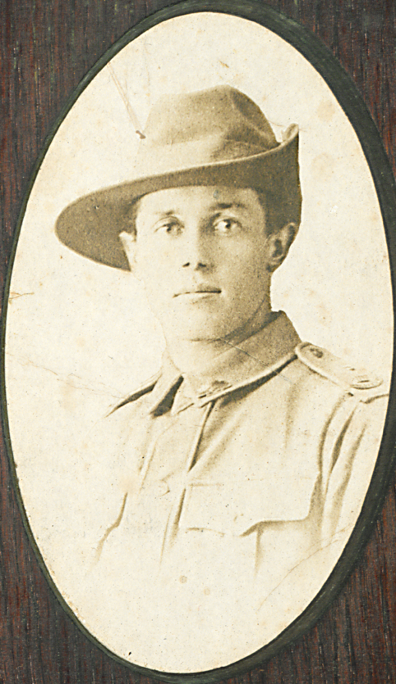
George Brown
Lance Corporal, No. 1892
35th Battalion, 9th Infantry Brigade, 3rd Australian Division
Killed in action 12 October 1917, Passchendaele, Belgium
No known grave. Commemorated the Ypres (Menin Gate) Memorial, Ypres, Belgium
George Brown was born in Lancashire, England, in about 1888. He enlisted in the AIF in March 1916 and left behind his wife, Eva Elizabeth Brown. At the time they were living at ‘Ashton’, 38 Plunkett Street, Drummoyne. George served with the 35th Battalion as part of the 3rd Australian Division and saw action at Messines, and in the following Third Battle of Ypres. He was killed in action during the attack on Passchendaele Ridge and his remains were never found. George is commemorated at the Ypres (Menin Gate) Memorial at Ypres, Belgium.
Harrie Montague Carr-Boyd
Gunner, No. 4273
5th Field Artillery Brigade, 2nd Australian Division
Killed in action 24 April 1917, Noreuil Valley, France
Buried Grevillers British Cemetery, France
He died that we may live
Montague Boyd-Carr was born at Wallsend in NSW in about May 1888, and he enlisted at the age of 27 in the AIF on 15 September 1915 with his brother Gerald. Initially allocated to be a reinforcement to the 2nd Battalion, Harrie was transferred to the field artillery, serving ultimately with the 5th Field Artillery Brigade. While serving with the brigade at Bullecourt, Harrie was wounded and eventually died of those wounds on 24 April 1917. Harrie is buried at Grevillers British Cemetery, France.
Photo published in the Sydney Mail of Harrie and Gerald Carr-Boyd on 16 May 1917 – Gunners Harrie and Gerald Carr-Boyd. (1917, May 16). Sydney Mail (NSW: 1912–1938), p. 24. Retrieved February 28, 2023. Source

Thomas Arthur Clegg
Private, No. 1931
3rd Battalion, 1st Infantry Brigade, 1st Australian Division
Killed in action, 6–12 August 1915, Lone Pine
Buried Lone Pine Cemetery, Gallipoli
"Thy Will Be Done"
Thomas Arthur Clegg was born in about 1893 in Lochinvar, NSW. He was however, along with the extended Clegg family, more closely associated with the Illawarra district. A carpenter by profession, at the time of his enlistment, Thomas was working locally in Drummoyne and had at one time attended Drummoyne Technical College. Thomas joined the 3rd Battalion with his brother Herbert as a reinforcement on the Gallipoli peninsula in time for the attack on Lone Pine in August 1915. Thomas was reported to have been killed in action on the first day of the attack and is buried at Lone Pine Cemetery.
Photo of Thomas Arthur Clegg courtesy of his descendants
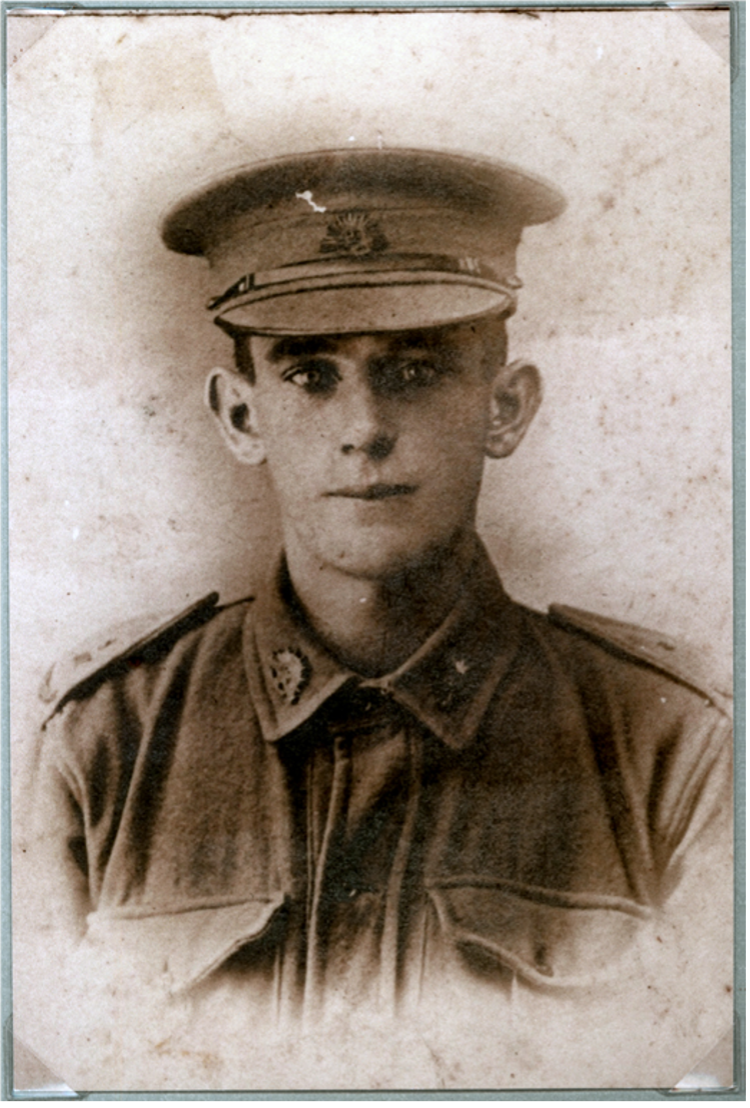
Sidney Harold Colley
Private No. 38
34th Battalion, 9th Infantry Brigade, 3rd Australian Division
Killed in action 7 June 1917, Messines, Belgium
No known grave. Commemorated the Ypres (Menin Gate) Memorial
Sidney Harold Colley was born in 1896 at Inverell NSW and at the time of his enlistment in November 1915, he was married to Maude Colley, who lived at Neutral Bay. His parents, Charles and Sarah Anne Colley, lived at College Street, Drummoyne, at that time. Sidney served with the 34th Battalion and was killed in the attack on Messines Ridge outside of Ypres in Belgium. He has no known grave and is commemorated on the Ypres (Menin Gate) Memorial.
Edmund Henry Collins
Private No. 4268
29th Battalion, 8th Infantry Brigade, 5th Australian Division
Killed in action 23 March 1917, Beaumetz, France
Buried Lebucquière Communal Cemetery Extension, Beaumetz, France
Son of Robert and Winifred Collins, brother of Mary Cullenward
Edmund Henry (Jack) Collins was born in 1886 in Queensland. The Collins family subsequently moved to Drummoyne, and Jack attended Holy Cross College, Ryde, and Hawkesbury Agricultural College. Employed as an assayer, Jack applied to enlist in the AIF in March 1916. Like so many men who volunteered to fight with the AIF, Jack’s military career was short lived – he was killed the day after he first joined his unit, the 29th Infantry Battalion, near Beaumetz, France on 23 March 1917. Jack is buried at Lebucquière Communal Cemetery Extension, Beaumetz, France.
Photograph of the gravestone of Edmund Henry (Jack) Collins at Lebucquière Communal Cemetery Extension.
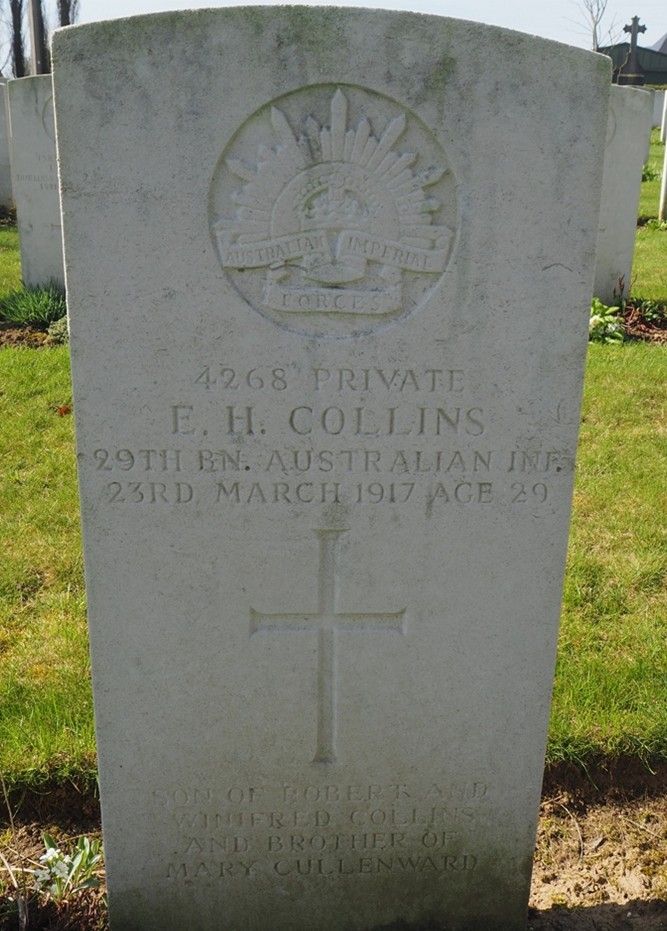
Ernest Ivon Collins (aka Frederick Condon)
Private, No. 2881B
19th Battalion, 5th Infantry Brigade, 2nd Australian Division
Killed in action 3 May 1917, Bullecourt, France
No known grave. Commemorated Australian National Memorial, Villers-Bretonneux, France
Ernest Ivon Collins enlisted in the AIF at Bathurst on 24 April 1916 under the nom de guerre Frederick Condon. Born in about 1887 in Singleton, NSW, Ernest nominated his mother Ada Matilda Collins of ‘Dochra’ 3 Alexandra Street, Drummoyne, as his next of kin. A labourer by occupation, Ernest was assigned as a reinforcement to the 19th Battalion and joined his unit in April 1917 just as it was preparing to launch a second attempt to capture the fortified village of Bullecourt. Ernest was killed in his first action on about 3 May 1917 and his remains were never recovered. He is commemorated on the Australian National Memorial, Villers-Bretonneux.
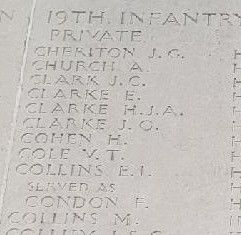
Joseph Ignatius Connell
Private, No. 6619
8th Field Ambulance, 8th Brigade, 5th Australian Division
Killed in action 26 October 1917, Passchendaele, Belgium
Buried Lijssenthoek Military Cemetery, Ieper (Ypres), Belgium
"Sweet Jesus have mercy on his soul"
Joseph Ignatius Connell was born in about 1895, the son of Thomas and Johanna Connell. A carpenter and joiner, Joseph worked at York Street Workhouse in Sydney and was living at 29 Dening Street, Drummoyne, at the time of his enlistment on 7 April 1915. He was assigned to the 8th Field Ambulance and as a stretcher bearer saw service at Fromelles, Bullecourt, Polygon Wood and Ypres. It was during the Third Battle of Ypres that Joseph was mortally wounded by a shell explosion. After evacuation, he died from his wounds and was buried at Lijssenthoek Military Cemetery.
Photograph of the headstone of the grave of Joseph Connell, Lijssenthoek Military Cemetery.
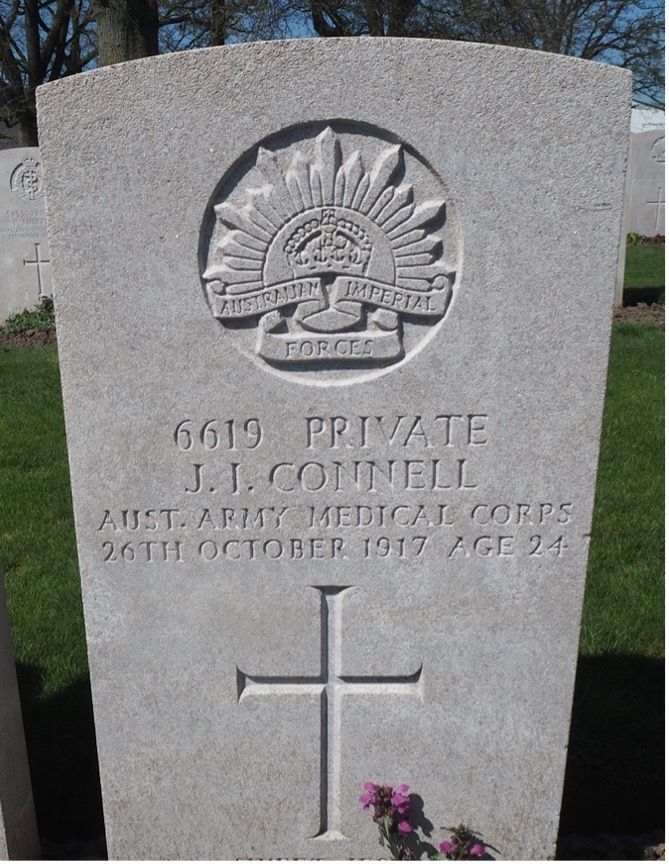
John Stephen Coolahan MC
Lieutenant
5th Machine Gun Company, 2nd Australian Division
Died of wounds 3 May 1918 in captivity
Buried Valenciennes Communal Cemetery, France
John Stephen Coolahan was born in Tamworth, NSW, on 30 October 1882. He was a single 33-year-old man when he enlisted in the AIF on 13 December 1915, and may well have enlisted on the same date as his brother, Arthur Francis Coolahan. At the time of enlistment, John’s occupation was that of a salesman and he gave his address as ‘Latonaville’, St Georges Crescent, Drummoyne. He was commissioned as a lieutenant and served with the 5th Machine Gun Company as part of the 2nd Australian Division. He saw action in Belgian Flanders in September 1917 where he was awarded the Military Cross for gallantry and was subsequently wounded in October 1917. John fought at Villiers-Bretonneux in April 1918, during which he was wounded and captured. He eventually died of his wounds in German captivity on 3 May 1918 and is buried at the Valenciennes Communal Cemetery, France.
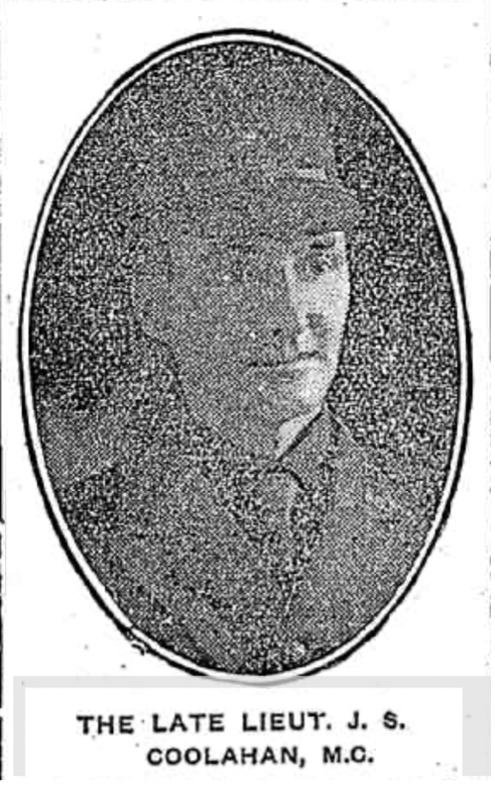
Lawrence Cornish
Private, No. 2266
4th Battalion, 1st Infantry Brigade, 1st Australian Division
Killed in action, Lone Pine 6–9 August 1915
No known grave. Commemorated at Lone Pine Memorial, Gallipoli
Lawrence Cornish was one of two sons of George and Annie Cornish who enlisted in the AIF. Lawrence’s military career would be a brief one, joining the 4th Battalion as a reinforcement just before the attack on Lone Pine. Lawrence’s precise fate is unknown. Initially reported as missing in action sometime between 6–9 August 1915, he was determined to have been killed in action. His body was either never identified or recovered, and Lawrence is commemorated on the Lone Pine Memorial as one of the 3,268 Australians who fought on the Gallipoli peninsula but who have no known grave.
Photograph of Lawrence Cornish – source HEROES OF THE DARDANELLES. (1915, October 19). The Sydney Morning Herald (NSW: 1842-1954), p. 5. Retrieved June 17, 2023, from
http://nla.gov.au/nla.news-article15619954 and Men of Gallipoli. (1915, November 10). Sydney Mail (NSW: 1912-1938), p. 24. Retrieved June 17, 2023, from
http://nla.gov.au/nla.news-article162493716
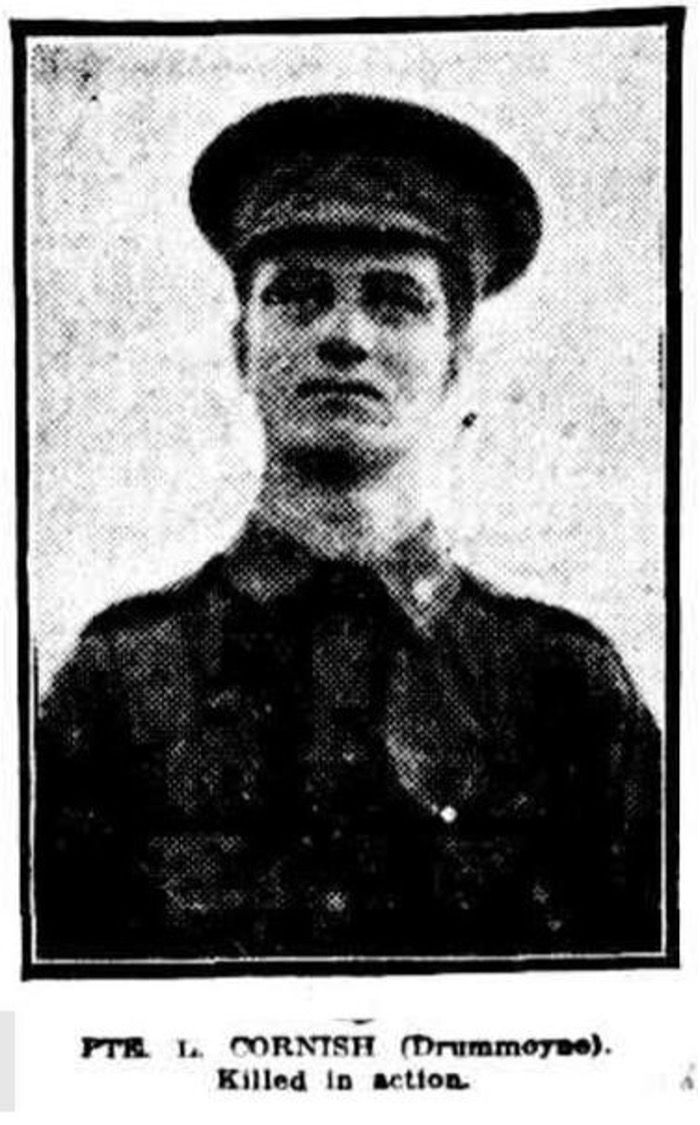
Edward James Cummings
Private, No. 2052
3rd Battalion, 1st Infantry Brigade, 1st Australian Division
Died of wounds 3 August 1915, Gallipoli
Buried East Mudros Military Cemetery, Lemnos, Greece
"GOD BE WITH YOU TILL WE MEET AGAIN"
Edward Cummings was born in England and was in Australia on a ‘sojourn’ when war was declared. Living with Mrs M Bulfin on Napier Street, Drummoyne, Edward enlisted in January 1915, eventually joining the 3rd Battalion as a reinforcement on the Gallipoli peninsula in June 1915. Edward suffered a head wound from shrapnel while at Gallipoli and was evacuated but died of his wounds. He is buried on the island of Lemnos in the Aegean Sea.
Photograph of Edward Cummings source - HEROES OF THE DARDANELLES. (1915, September 9). The Sydney Morning Herald (NSW: 1842-1954), p. 5. Retrieved October 22, 2022, from http://nla.gov.au/nla.news-article15612534
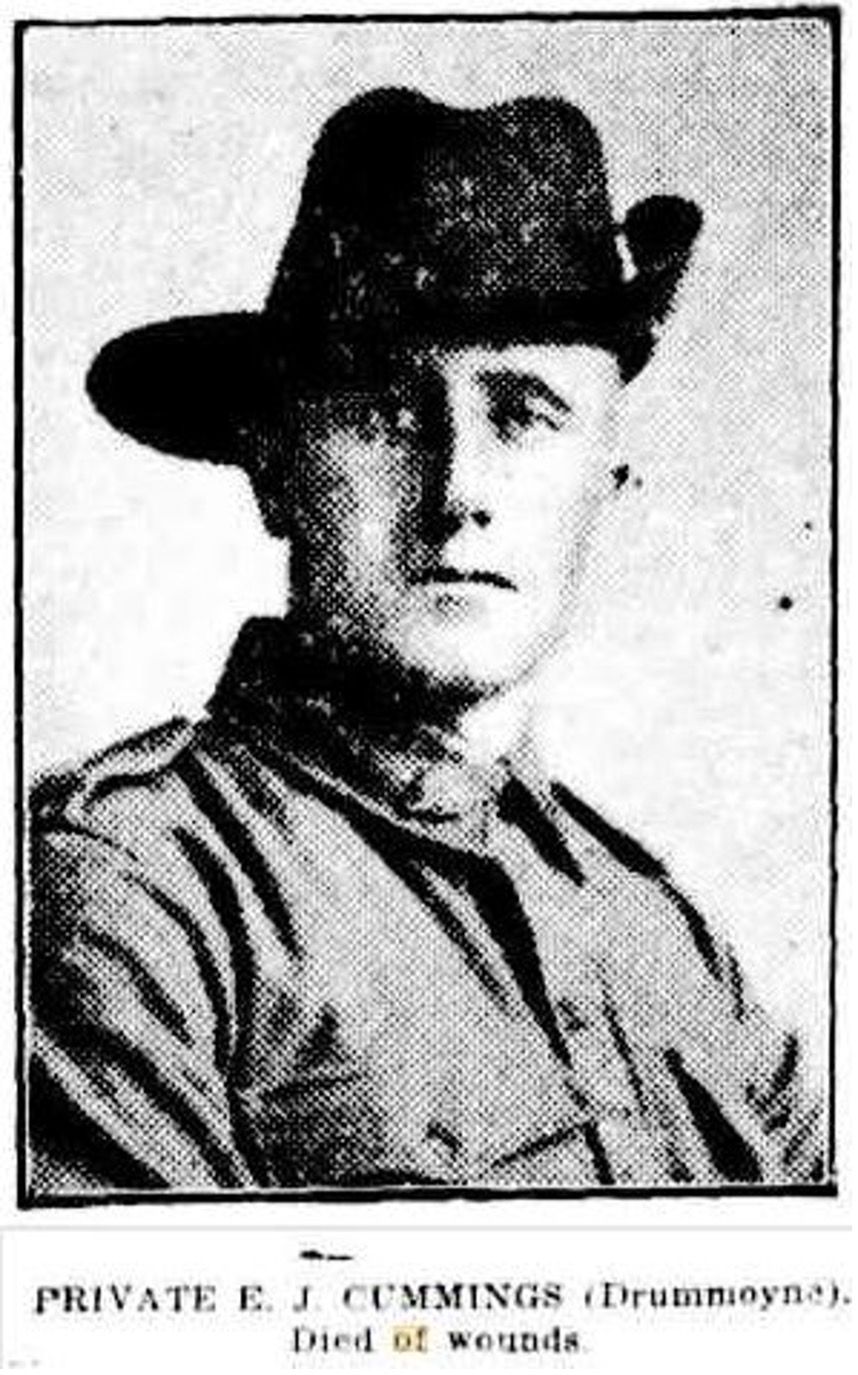
Bernard Patrick Dawson
Private, No. 2125
2nd Battalion, 1st Infantry Brigade, 1st Australian Division
Killed in action 6–9 August 1915, Lone Pine, Gallipoli
Believed to be buried Lone Pine Cemetery, Gallipoli.
"Their Glory Shall Not Be Blotted Out"
Bernard Patrick Dawson was born in Orange in 1887 and worked as a postman at Drummoyne Post Office when he enlisted in the AIF in April 1915. Like a number of the men commemorated on the Drummoyne War Memorial, Bernard’s military career was a brief one; he joined the 2nd Battalion at Gallipoli on 6 August and was reported missing almost immediately. He was subsequently determined to have been killed in action in the attack on Lone Pine sometime between 6 and 9 August 1915. His body was never found and it is believed that he was buried sometime after the battle in Lone Pine Cemetery.
Studio portrait of 2125 Private Bernard Patrick Dawson, 2nd Battalion of Woollahra – source Australian War Memorial (P08624.038). Public Domain
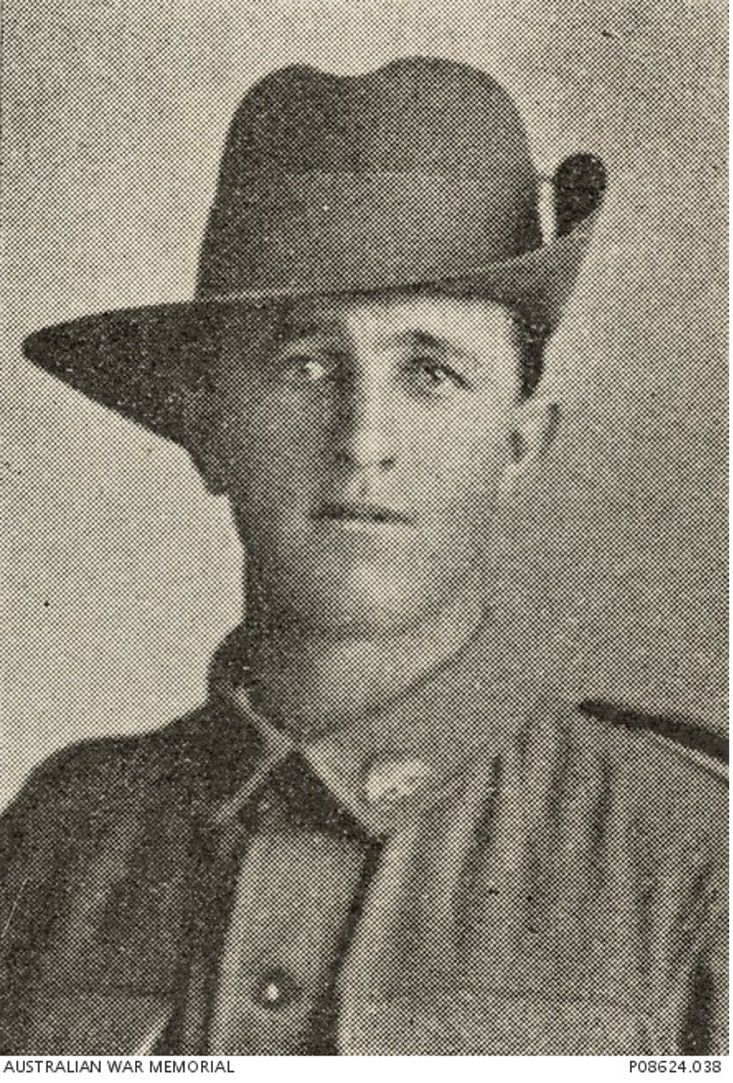
Downie Dodd
Private, No. 4770
56th Battalion, 14th Infantry Brigade, 5th Australian Division
Killed in action 19 July 1916, Fromelles
No known grave. Commemorated at V.C. Corner Australian Cemetery and Memorial, Fromelles, France
Downie Dodd was born in Glasgow, Scotland, in about March 1883. Downie enlisted in the AIF in November 1915 and sailed in January 1916 for Egypt, ultimately destined for service in France on the Western Front. Downie was killed on 19 July 1916 in the debacle that was the Battle of Fromelles. Initially listed as missing in action, his identity disc was returned by German authorities through the Red Cross in September 1916 confirming his death. Downie has no known grave and is commemorated at the V.C. Corner Australian Cemetery and Memorial at Fromelles.
Studio portrait of 4770 Private (Pte) Downie Dodd, 56th Battalion. Lemaire Studios c January 1916. AWM ID Number P11736.002.
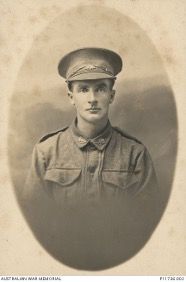
John Donald Edwards
Private, No. 3093
53rd Battalion, 14th Infantry Brigade, 5th Australian Division
Killed in action 31 August 1918, Peronne, France
Buried Herbecourt British Cemetery, France
"Tread softly by our hearts are here with our beloved Jack"
John Donald Edwards enlisted in the AIF in May 1916 with his father’s consent at the declared age of 18 years and two months when in fact he was only 17. The son of Thomas Norris Edwards and Mary Ann Edwards of “Dervin” 5 Broughton Street, Drummoyne, John was employed as a farmer and enlisted in the district of West Maitland. Initially assigned to a Pioneer Battalion, John had a number of temporary assignments before being transferred to the 53rd Infantry Battalion. John was severely wounded outside Peronne in the lead up to the Australian attack to take the town at the end of August 1918 and died of his wounds. John is buried at Herbecourt British Cemetery, France.
Photograph of the grave of John Edwards at Herbecourt British Cemetery, France.
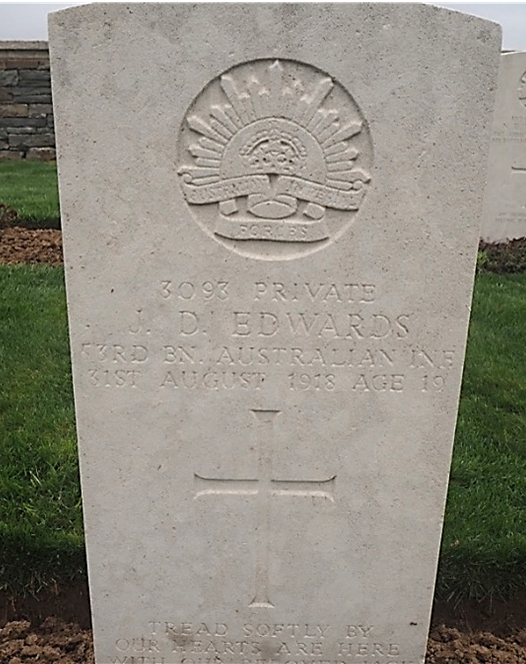
Bertie George Englert
Private, No. 7342
14th Battalion, 4th Infantry Brigade, 4th Australian Division
Killed in action 31 May 1918, Allonville, France
Buried Allonville Communal Cemetery, France
"Gently sleeping till the day dawns"
Bertie George Englert was a native of Dungog, NSW, but was living in Westbourne Street, Drummoyne, with his wife Ruth at the time he enlisted in the AIF in October 1916. Bertie briefly served with the 14th Battalion joining it in late April 1918 near Villers-Bretonneux. He was killed a month later along with many of his comrades when shell landed in their billets. He is buried in Allonville Communal Cemetery near Amiens.
Studio portrait of Bertie Englert (courtesy Englert family).
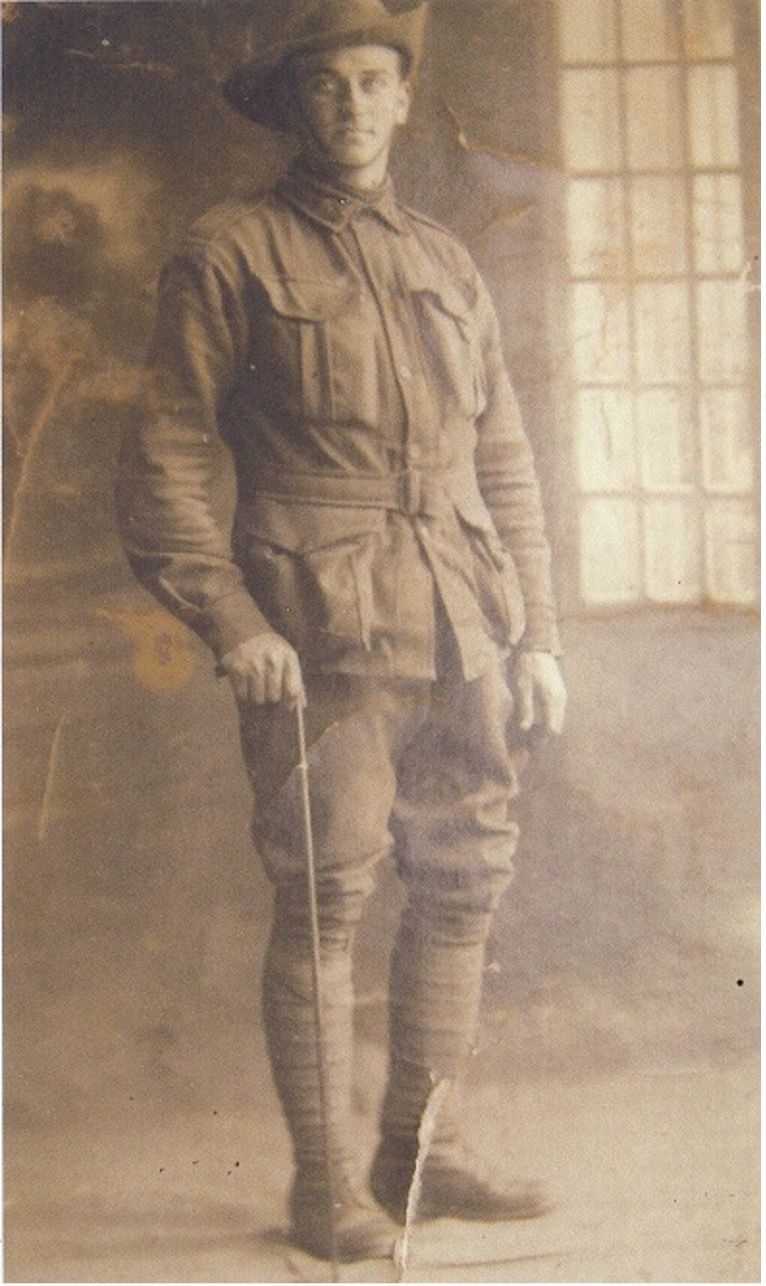
Roy Robert Erickson & Albert Victor Erickson
Roy Robert Erickson
Private, No. 2364
18th Battalion, 5th Brigade, 4th Australian Division
Killed in action 5 August 1916, Pozieres, France
Buried Pozieres British Cemetery, Ovillers-La-Boisselle, France
Albert Victor Erickson
Private, No. 3046
45th Battalion, 12th Brigade, 4th Australian Division
Killed in action 6 August 1916, Pozieres, France
Buried Serre Road Cemetery No.2, Beaumont Hamel, France
Roy and Albert were two of four brothers who enlisted in the AIF in the First World War. Their parents, John Paul and Margaret Jane Erickson lived at 3 Thornley Street, Drummoyne. Roy enlisted in July 1915 and Albert in August 1915, and both become part of the doubling of the AIF in Egypt prior to embarking for service in France. Both Albert and Roy were killed in their first major action at Pozieres within 24 hours of each other. Their elder brother, George, was badly wounded at Pozieres in July 1916. Initially posted as wounded and missing, both Albert and Roy were determined in April 1917 to have been killed in action. Roy’s body was reinterred at the Pozieres British Cemetery in 1921, and Albert’s body was found in 1929 when it was exhumed and reinterred at Serre Road Cemetery.

Alfred Douglas Erwin
Private, No. 2365
18th Battalion, 5th Infantry Brigade, 2nd Australian Division
Killed in action 5 August 1916, Pozieres, France
No known grave. Commemorated at Australian National Memorial, Villers-Bretonneux, France.
Alfred Erwin was the eldest child of Alfred James and Amy Erwin who lived on Lyons Road, Drummoyne. He enlisted with his best friend Roy Erickson in July 1915. Alfred and Roy trained, embarked for overseas, fought, died and were buried together after being killed by the same shell on 5 August 1916 at Pozieres. Although Roy’s body was located in 1921 and interred at Pozieres British Cemetery, Alfred’s remains were not found and he is commemorated at the Australian National Memorial, Villers-Bretonneux, France.
Studio portrait of 2365 Private (Pte) Alfred Douglas Erwin, 18th Battalion, of Drummoyne, NSW. AWM ID No. P06565.001. Public domain.
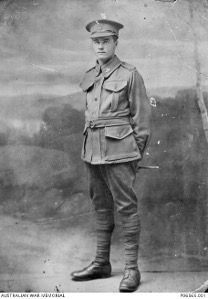
Gainsford Wilton Evans
Private, No. 7114
13th Battalion, 4th Infantry Brigade, 4th Australian Division
Killed in action 11 April 1918, Villers-Bretonneux, France
No known grave. Commemorated Australian National Memorial, Villers-Bretonneux, France
Gainsford Evans was born at Bega but was living at Day Street, Drummoyne, when he first enlisted in the AIF in January 1916. Subsequently discharged, Gainsford enlisted again in November 1916 and joined the 13th Battalion as a reinforcement in July 1917. Gainsford saw service with the battalion in the Ypres sector of Belgium, before being transferred to Villers-Bretonneux in March 1918 to assist in the repulse the German offensive that threatened the city of Amiens. Gainsford was killed in action on 11 April 1918 and is commemorated at the Australian National Memorial, Villers-Bretonneux, France.
Photograph of Gainsford Evans - https://vwma.org.au/explore/people/182223

Jack Hammond Fitzgerald
Driver, No. 22189
8th Field Artillery Brigade, 3rd Australian Division
Killed in action 26 September 1917, Menin Road, Ypres
Buried The Huts Cemetery, Dickebusch, Belgium
Jack Hammond Fitzgerald was a native of Carlton North, Victoria, who had no association with Drummoyne other than that his sisters lived in the suburb at the time of his enlistment and for a period until after the war. Jack was assigned to artillery as a driver and arrived in England in July 1916. He eventually sailed for France at the end of 1916 where he was transferred to the 8th Field Artillery Brigade. He served in the front lines around Ypres in Belgium with the 3rd Australian Division. A week before he was killed in action, Jack applied to be reassigned as a gunner in his battery. Jack was killed by a direct shell that took out his battery, and he is buried at The Huts Cemetery, Dickebusch, Belgium.
Edward (Edgar) Allen Fountain
Private, No. 6386 (and 3066)
2nd Battalion, 1st Infantry Brigade 1st Australian Division
Killed in action 9 April 1917, Hermies, France
No known grave. Commemorated Australian National Memorial, Villers-Bretonneux, France
Edgar Allen Fountain was born in Drummoyne in about 1896. Edgar enlisted in the AIF in August 1915 but was discharged four months later. Not dissuaded, he re-enlisted as Edward Fountain in March 1916 and joined as a reinforcement to the 2nd Battalion in January 1917. Edward participated in his first and only action at Hermies, France, in April 1917 where he was killed. He has no known grave and is commemorated at the Australian National Memorial, Villers-Bretonneux, France.
Studio portrait of 6386 Private (Pte) Edward Allen Fountain. c 1916. AWM P11898.001 (public domain).

George Campbell Gear
Trooper, No. 3534
6th Light Horse Regiment, 2nd Light Horse Brigade
Killed 29 March 1918, Amman, Palestine
Buried Jerusalem War Cemetery, Israel
George Gear was born in Ashfield, NSW, the son of George Powell Gear and Barbara Gear. He was married to Mary Gear at the time of his enlistment in May 1917, and they had three young children. George was assigned as a reinforcement to the 6th Light Horse Regiment, which was serving in Palestine. He was hit by machine gun fire on the outskirts of Amman and died after being evacuated to a field ambulance. George is buried in the Jerusalem War Cemetery, Israel.
Sidney Goode
Lance Corporal, No. 5088
13th Battalion, 4th Infantry Brigade, 4th Australian Division
Killed in action 29 August 1916, Mouquet Farm, France
No known grave. Commemorated at Australian National Memorial, Villers-Bretonneux, France
Sidney Goode was born in Drummoyne in about 1898 and was the son of Alfred and Sarah Goode who lived at 32 St Georges Crescent, Drummoyne. He enlisted in January 1916 and was assigned as a reinforcement to the 13th Battalion. Joining his battalion in France in July 1916 then serving on the Somme, Sidney would be killed by a shell during the attack on Mouquet Farm. His body was never recovered and he is commemorated at the Australian National Memorial at Villers-Bretonneux, France.
Ernest Gordon
Private, No. 21
4th Battalion, 1st Infantry Brigade, 1st Australian Division
Killed in action 15 April 1917, Hermies, France
No known grave. Commemorated Australian National Memorial, Villers-Bretonneux, France
Ernest Gordon was a native of Liverpool, England, and immigrated to Australia in about 1910. A fireman by occupation, Ernest joined the AIF within two weeks of the outbreak of the war in August 1914. Initially assigned to the 1st Infantry Brigade Headquarters as a driver, he served in the transport section of the brigade in Egypt. Ernest requested to be transferred to a front-line battalion in June 1916, but was soon taken ill and evacuated to England. After a period recuperating and then serving with the Provost Corps in England, Ernest finally joined the 4th Battalion in March 1917. Within a month, Ernest would be killed in action outside the village of Hermies. Although buried by comrades, his grave was lost and Ernest is commemorated at the Australian National Memorial, Villers-Bretonneux, France.
1914 St Bede’s (Anglican Church), Drummoyne baseball team. Players in the photograph, above, were back row: A. Norman (Pitcher), H. Kay (1st Base), L. Kay (Catcher), Honorary Treasurer E. Gordon (Centre Field); second row: F. Hall (3rd Base), A. E. Kelshaw (Short Stop), Captain A. Mackenzie (2nd Base), Vice-Captain and Honorary Secretary E. Stutchbury (Right Field); front row: E. Boon (Left Field), A Parsons (Centre Field). Reproduced with permission Local Studies, City of Canada Bay.
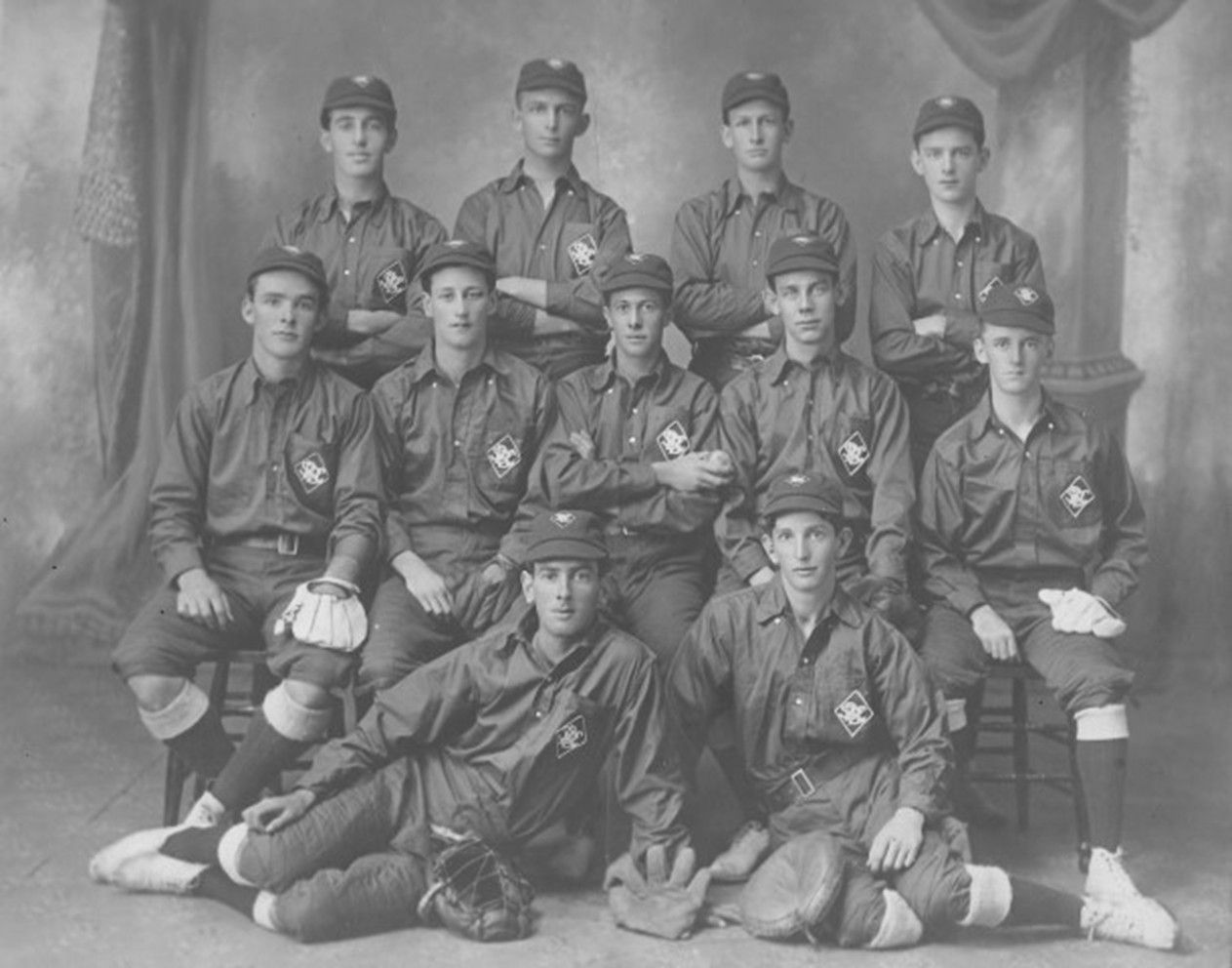
William Edward Greathead
Private, No. 339/2269
5th Battalion, 2nd Infantry Brigade, 1st Australian Division
Killed in action 18 August 1916, Mouquet Farm, France
No known grave. Commemorated at Australian National Memorial, Villers-Bretonneux, France
William Edward Greathead was the son of Robert and Ruth Greathead, who resided on College Street, Drummoyne. William enlisted very shortly after the outbreak of the war in 1914 and sailed for service overseas with the 1st Battalion. En-route to the Gallipoli landing, William was disembarked on Lemnos with venereal disease. Returned to Australia, William re-enlisted in Melbourne and was assigned to the 6th Reinforcements to the Victorian 5th Battalion. William served briefly at Gallipoli before being evacuated seriously ill with dysentery. William did not finally rejoin the 5th Battalion until June 1916 and was killed in action at Mouquet Farm in August 1916. William’s remains were never recovered and he is commemorated at the Australian National Memorial, Villers-Bretonneux, France.
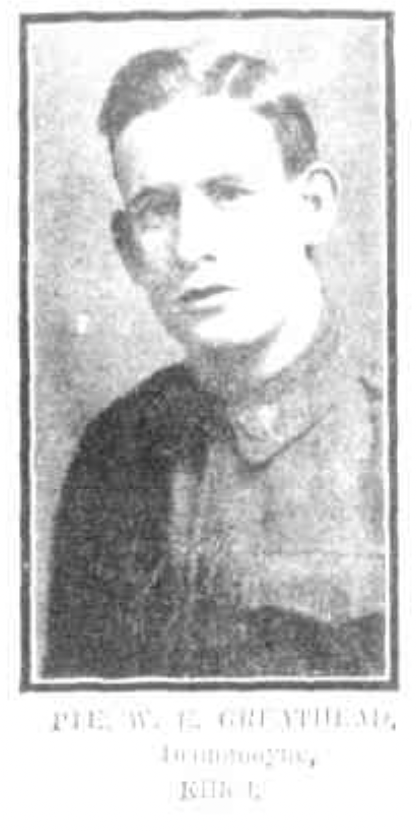
Ernest Walter Harding
Private, No. 238
17th Battalion, 5th Infantry Brigade, 2nd Australian Division
Killed in action 3 May 1917, Bullecourt, France
No known grave. Commemorated Australian National Memorial, Villers-Bretonneux, France
Ernest ‘Hoppy Chivers’ Harding was a native of England and moved to Australia shortly before the outbreak of the war with his family. Ernest enlisted in the AIF on 22 February 1915 and spent more time in hospital than on active duty. Assigned to the 17th Battalion, Ernest saw service in the final months of the Gallipoli campaign, and on the Western Front. He was killed in action at the Second Battle of Bullecourt. Although his comrades saw his body on the German wire, it was not recovered and he has no known grave. Ernest is commemorated on the Australian National Memorial at Villers-Bretonneux.
Stephen John Harrison
Private No. 6746
1st Battalion, 1st Infantry Brigade, 1st Australian Division
Killed in action 3 October 1917, Passchendaele, Belgium
Buried Tyne Cot Cemetery, Passchendaele, Belgium
Stephen Harrison enlisted in the AIF at the age of 18 in July 1916. One of three brothers, he gave his brother William as his next of kin then living with a Mrs Thompson on Lyons Road, Drummoyne. He was assigned to the 22nd Reinforcements to the 1st Battalion and embarked from Sydney in November 1916 for service in Europe. After a period training at Salisbury in the United Kingdom, Stephen was taken on strength with the 1st Battalion in May 1917 just after the Second Battle of Bullecourt, during which his other brother Richard, who was serving with the 18th Battalion, was badly wounded. Stephen served with the 1st Battalion during the battles comprising the Third Battle of Ypres and was killed in action at Passchendaele in October 1917. Stephen’s remains were recovered and buried in Tyne Cot Cemetery.
Photograph of the headstone of the grave of Stephen Harrison, Tyne Cot Cemetery, Belgium.

Joseph Marcus Harwood
Lance Corporal, No. 3055
45th Battalion, 12th Infantry Brigade, 4th Australian Division
Killed in action 13 October 1917, Passchendaele, Belgium
Buried Tyne Cot Cemetery, Passchendaele, Belgium
Australia will have other sons but none more honoured than these
Joseph Harwood was 18 and a half years old at the time to his enlistment in the AIF in July 1915. Although initially assigned to the reinforcements to the 13th Battalion, on arrival in Egypt in March 1916, he was transferred to the 45th Battalion as part of the doubling of the AIF. Joseph served with the battalion in the Somme sector of France, prior to its move to Ypres sector in Belgium Flanders. He was wounded during the attack on Messines Ridge in June 1917 before he was killed during the subsequent assault on Passchendaele Ridge in October 1917 during the Third Battle of Ypres. Joseph is buried at Tyne Cot Cemetery, Passchendaele, Belgium.
Photograph of Joseph Harwood (source Ancestery.com)
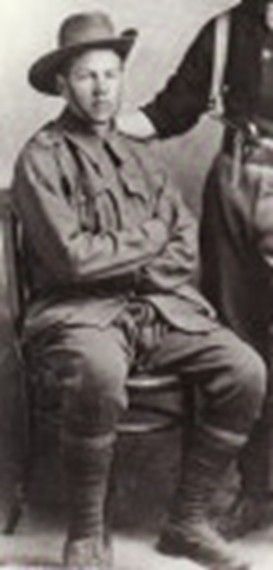
Michael Hawley
Private, No. 3538
53rd Battalion, 14th Infantry Brigade, 5th Australian Division
Killed in action 19 July 1916, Fromelles, France
No known grave. Commemorated at V.C. Corner Australian Cemetery and Memorial, Fromelles, France
Michael Hawley was born in 1892 at Morpeth, NSW, the son of Thomas and Catherine Hawley. He was 23 years old when he enlisted in the AIF on 3 August 1915. On his enlistment papers his occupation was noted to be a labourer, and his parents’ address as 44 Cary Street, Drummoyne. There is precious little information on Michael Hawley, primarily because his military career was a short one – he was killed in his first action at Fromelles.
Spencer Alexander Hayman
Private, No. 1127
3rd Battalion, 1st Infantry Brigade, 1st Australian Division
Died of wounds 25 May 1915, Gallipoli
Buried at sea. Commemorated at Lone Pine Memorial, Gallipoli
Spencer Alexander was the only son of William and Ann Jane Hayman of Renwick Street, Drummoyne. A trainee accountant, Spencer enlisted at the age of 19 within a month of the outbreak of the war and was assigned to the 3rd Battalion. Spencer was part of the first convoy of the AIF that sailed for Egypt and was part of the forces that landed on ANZAC Cove on 25 April 1915. Spencer was wounded within the first month and evacuated from the peninsula. He died of wounds while on a hospital ship in the Aegean Sea and was buried at sea on 25 May 1915. Spencer is commemorated on the Lone Pine Memorial, Gallipoli.
Photo - HEROES OF GALLIPOLI. (1915, June 8). The Daily Telegraph (Sydney, NSW: 1883-1930), p. 9. Retrieved October 23, 2022, from
http://nla.gov.au/nla.news-article239035437; New South Wales. (1915, June 16). Australian Town and Country Journal (Sydney, NSW: 1870-1919), p. 16. Retrieved October 23, 2022, from
http://nla.gov.au/nla.news-article263870211
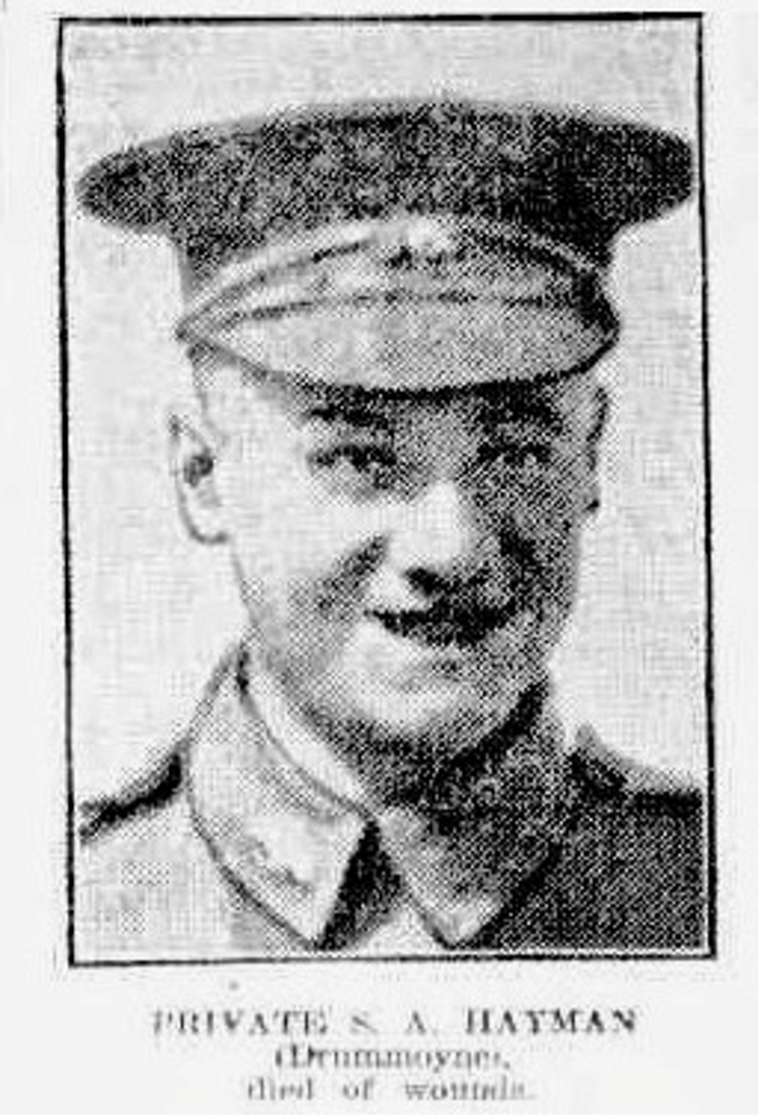
Robert James Henderson MC & Bar
Captain
13th Battalion, 4th Infantry Brigade, 4th Australian Division
Died of wounds 13 May 1918
Buried Etaples Military Cemetery, Etaples, France
Robert James Henderson was the eldest son of James Henderson and Amy Violet Henderson who lived at 133 St Georges Crescent, Drummoyne. Robert enlisted as a private in the AIF in May 1915 and briefly served on Gallipoli with the 13th Battalion before the evacuation. In Egypt, he was commissioned as an officer in the battalion and fought at Mouquet Farm in August 1916 where he was twice commended for his gallantry and was wounded. After an extensive period of convalescence in England, Robert rejoined the battalion in April 1917 in time for the Battle of Messines in Belgian Flanders, where he was again wounded and this time awarded the Military Cross for his actions. Promoted to captain, Robert was badly wounded for the third time outside of Villers-Bretonneux on 2 May 1918. Evacuated to a hospital, he died of his wounds on 13 May 1918 and was posthumously awarded a bar to his Military Cross. Robert is buried at Etaples Military Cemetery, Etaples, France.
Photograph of Robert Henderson that was published in No title (1918, June 19). Sydney Mail (NSW: 1912-1938), p. 20. Retrieved May 23, 2023, from http://nla.gov.au/nla.news-article159026484

Harold Leslie Henley
Captain
13th Battalion, 4th Infantry Brigade, 4th Australian Division
Killed in action 15 August 1916, Mouquet Farm, France
No known grave. Commemorated at Australian National Memorial, Villers-Bretonneux, France
Harold Leslie Henley was born in 1893 and was the son of the Hon. Sir Thomas Henley KBE MLA, and Lady Charlotte Henley of Tudor House, College Street, Drummoyne. Leslie was a university student at the time of his enlistment, which occurred a week after war had been declared. Leslie first served with the ANMEF in German New Guinea, and on discharge, enlisted in the AIF. He was commissioned as a lieutenant and placed in command of the 7th Reinforcements to the 13th Battalion. He saw service on the Gallipoli peninsula and was promoted to captain after the evacuation. Leslie was involved in the 4th Division’s first action on the Western Front at Mouquet Farm, near Pozieres. He was killed by a high explosive shell while leading his company out of the line. He has no known grave and is commemorated at the Australian National Memorial, Villers-Bretonneux, France.
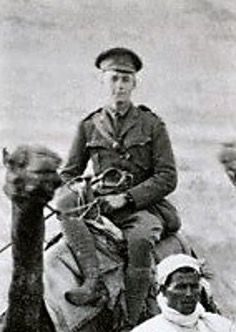
Edward Lynes Heydon
Trumpeter, No. 110
1st Field Artillery Brigade, 1st Australian Division
Killed in action 21 December 1916, Montauban, France
Buried Quarry Cemetery, Montauban, France
Loved in life, honoured in death
Sadly missed, one of the best.
Edward Lynes Heydon was born in about 1881 to Thomas Edward and Annie Margaret Heydon who lived at 3 Market Street, Drummoyne. Edward was a professional soldier serving with the Royal Australian Field Artillery at the outbreak of the war in 1914 and sailed with one of the first contingents of the AIF, serving in Egypt, Gallipoli and eventually France. It was while being evacuated ill with influenza in December 1916 that Edward was caught in a German artillery barrage at a railhead at Montauban and killed instantly. He was buried by his comrades in what would become Quarry Cemetery at Montauban.
Studio portrait of 110 Gunner Edward Lyons Heydon, 1st Field Artillery Brigade, of Sydney, c 1914. AWM P05301.137.

Frank Ireland
Private, No. 4509
2nd Battalion, 1st Infantry Brigade, 1st Australian Division
Killed in action 23 July 1916, Pozieres, France
No known grave. Commemorated at Australian National Memorial, Villers-Bretonneux, France
Frank Ireland was born in Scotland in about 1879 and emigrated with his family to Australia three years later. A machinist by occupation, Frank was married to Selina Ireland and they had a son, and lived at ‘Rubicon’, Tavistock Street, Drummoyne. Frank enlisted in the AIF on 23 August 1915 and joined the 2nd Battalion as a reinforcement in Egypt. Frank was involved in the 1st Division’s first major action on the Western Front at Pozieres where he was reported as killed in action. He has no known grave and is commemorated at the Australian National Memorial, Villers-Bretonneux, France.
Russell Thompson Sydney Jarvis MM
Lance Corporal, No. 11994
9th Field Ambulance, Australian Army Medical Corps
Killed in action 4 October 1917, Ypres, Belgium
Buried Ypres Reservoir Cemetery, Ypres, Belgium
"Greater Love Hath No Man Than To Lay Down His Life For His Friends"
Russell Thompson Sydney Jarvis was born in 1884 in Sydney and was the son of Charles and Margaret Jarvis. Russell was married to Alice Jarvis and employed as a proofreader with The Sydney Morning Herald at the time of his enlistment in August 1915. He was assigned to the 9th Field Ambulance as a stretcher bearer and served in France and Belgium in 1916 and 1917. While in action at the Battle of Messines in June 1917, Russell was awarded the Military Medal for saving four wounded men while under shell-fire. He was killed in action during the attack on Broodseinde Ridge on 4 October 1917 as part of the Third Battle of Ypres, and is buried at Ypres Reservoir Cemetery, Ypres, Belgium.
Photograph of Russell Jarvis from DISTINGUISHED SOLDIERS. (1917, October 10). Sydney Mail (NSW: 1912–1938), p. 6. Retrieved April 25, 2023, from http://nla.gov.au/nla.news-article160629284

Frederick Jordan
Private, No. 11832
2nd Battalion Sherwood Foresters (Notts and Derby Regiment), 18th Brigade, British 6th Division
Died of illness, 22 February 1919
Buried Nottingham Road Cemetery, Derby, Derbyshire
"He Fought the Good Fight"
Frederick Jordan was born in 1895 in Derby, England. Frederick was a reservist and enlisted in August 1914, assigned to the 2nd Battalion of the Sherwood Foresters (Notts and Derby Regiment). The battalion went to France to join the British Expeditionary Force in September 1914 and on 20 October, the battalion was holding a position near Bois Grenier in French Flanders, when it was overwhelmed by a German attack with a large number captured. Frederick was among the prisoners and remained in captivity until the end of the war. Repatriated shortly after the Armistice in November 1918, Frederick died of illness after returning to his home village in February 1919. Frederick is buried at Nottingham Road Cemetery, Derby, Derbyshire.
John Kilgour
Private, No. 2372A
1st Pioneer Battalion, 1st Australian Division
Died of Wounds, 18 September 1917, Ypres, Belgium
Buried Lijssenthoek Military Cemetery, Belgium
John Kilgour was a native of Scotland who emigrated to Australia at the age of 28 in about 1910. A house painter by occupation, John enlisted in the AIF with his brother James in April 1916, with both being assigned as reinforcements to the 1st Australian Pioneer Battalion. John arrived on the Western Front in France in March 1917 and moved to the Ypres sector in Belgium where he was severely wounded by a shell. Evacuated to a clearing station, John died of his wounds. He is buried at Lijssenthoek Military Cemetery, Belgium.
Photograph of the headstone to the grave of John Kilgour, Lijssenthoek Military Cemetery.
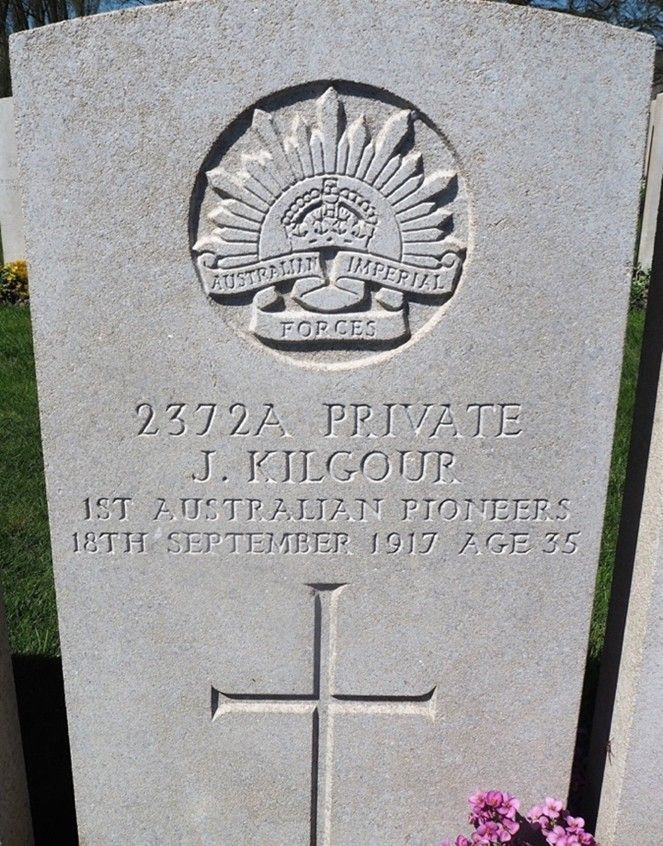
Phillip Barton Kirkwood
Private No. 604
4th Battalion, 1st Infantry Brigade, 1st Australian Division
Killed in action 19 May 1915, Gallipoli
Buried 4th Battalion Parade Ground Cemetery, Gallipoli, Turkey
Phillip Kirkwood was one of David and Jennie Kirkwood’s nine children, of whom four would serve in the AIF in the First World War. Phillip was born in 1894 in Concord, NSW. At the time of his enlistment, David and Jennie Kirkwood were living at ‘Speen’, 35 Wharf Road, Gladesville. Phillip, one of the youngest of the nine children, was the first to enlist in August 1914, and sailed with the first AIF contingent as part of the 4th Battalion. He served in Egypt and then at Gallipoli where he was killed in action at McLaurin’s Hill at ANZAC Cove. His brother William enlisted in March 1915 and was killed during the second battle of Bullecourt in May 1917.
HEROES OF THE DARDANELLES. (1915, June 23). The Sydney Morning Herald (NSW: 1842-1954), p. 14. Retrieved October 19, 2022, from http://nla.gov.au/nla.news-article15585601
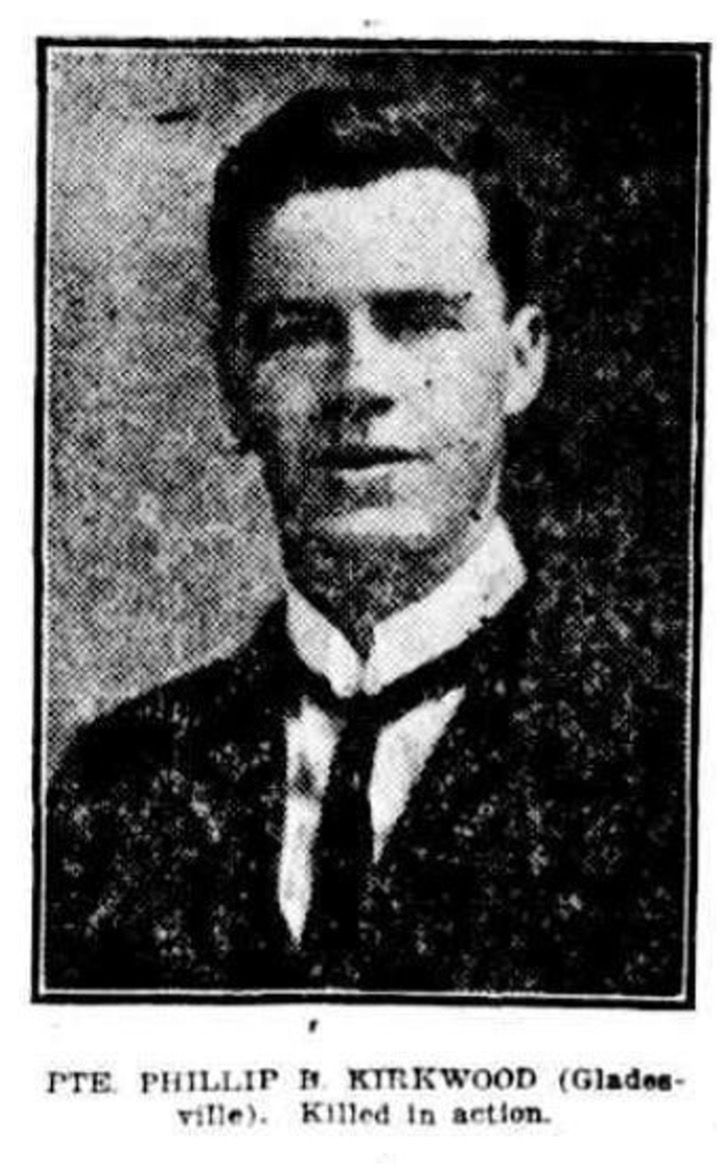
William Russell Barton Kirkwood
Lieutenant, No. 907
19th Battalion, 5th Infantry Brigade, 2nd Australian Division
Killed in action 3 May 1917, Bullecourt, France
No known grave. Commemorated Australian National Memorial, Villers-Bretonneux, France
William Kirkwood was one of nine children of David and Jennie Kirkwood, of whom four would serve in the AIF in the First World War. William was born in 1892 in Concord, NSW, and enlisted in March 1915 at which time his parents were living at ‘Speen’ 35 Wharf Road, Gladesville. William was assigned to the 19th Battalion initially as a sergeant before embarking in June 1915. He served at Gallipoli where he was wounded, and then moved to France where he was commissioned as an officer in August 1916. Wounded for a second time in fighting around Ypres, he returned to his unit just before the Second Battle of Bullecourt in May 1917, where he was said to have been killed by a sniper’s bullet. He has no known grave and is commemorated at the Australian National Memorial, Villers-Bretonneux.
Portrait of William Kirkwood obtained from original copy of The ANZAC Book held by Port Macquarie Museum.

Alexander MacKenzie
Lance Corporal, No. 3855
13th Battalion, 4th Infantry Brigade, 4th Australian Division
Died of wounds 18 April 1917 as prisoner of war
Buried Hamburg Cemetery, Germany
"Till the day breaks and the shadows flee away"
Alexander MacKenzie was born in Stornaway, Scotland, in about 1887. A shipwright by occupation, Alexander was living in Plunkett Street, Drummoyne, at the time of his enlistment in August 1915. Assigned to the 12th Reinforcements to the 13th Battalion, Alexander joined his battalion in Egypt in February 1916 before embarking for France. He saw action at Mouquet Farm, Ypres salient and Gueudecourt. In April 1917, the 13th Battalion was engaged in the Battle of Bullecourt during which Alexander was badly wounded and taken prisoner. Evacuated to a hospital at Verden near Hanover, Alexander died of his wounds and was buried at Hamburg Cemetery, Germany.
Arthur Cobcroft MacKenzie
Captain
1st Battalion, 1st Infantry Brigade, 1st Australian Division
Killed in action 23 July 1916, Pozieres, France
Buried Pozieres British Cemetery, Ovillers-La-Boiselle, France
Arthur MacKenzie was born in 1891 to Arthur and Ella MacKenzie. A master baker by profession, Arthur was living on Bridge Road, Drummoyne, at the time of his enlistment in August 1915. Owing to having served four years with the Senior Cadets as a captain, he applied for a commission in the AIF. Arthur was commissioned as a lieutenant and assigned to the 8th Reinforcements to the 1st Battalion, which at the time was already fighting on the Gallipoli peninsula. Arthur saw service towards the end of the Gallipoli campaign before evacuation to Egypt. He transferred to the Western Front in March 1916 and was promoted to the rank of captain. Arthur fought in one of the AIF’s first major engagements in France, at Pozieres, where he was killed in action early in the offensive. Arthur’s body was recovered and he is buried at Pozieres British Cemetery, Ovillers-La-Boiselle, France.
Photo of headstone of Arthur MacKenzie’s grave at Pozieres British Cemetery, Ovillers-La-Boiselle, France.

Thomas Henry McKinnon
Private, No. 1822
46th Battalion, 12th Infantry Brigade, 4th Australian Division
Died by accident, 25 June 1916
Buried Bailleul Communal Cemetery Extension, France
‘Tho out of sight to memory dear.’ Mother
Thomas McKinnon was born in Balmain in 1892, the son of Lachlan and Eliza McKinnon. Thomas initially enlisted in January 1915 and was assigned to the 6th Australian Light Horse Regiment, and briefly saw active service on ANZAC Cove before he was evacuated suffering from venereal disease. Returned to Australia, he transferred to the infantry and was reassigned to the 2nd Reinforcements to the 29th Battalion, re-embarking for Egypt at the end of 1915. In Egypt, he was reassigned to the 46th Battalion and sailed for France, arriving in June 1916. His period of service was short-lived as he was involved in a car accident and died of his injuries. Thomas is buried in Bailleul Communal Cemetery Extension, France.
Photograph of the headstone of Thomas McKinnon’s grave at Bailleul Communal Cemetery Extension, France.
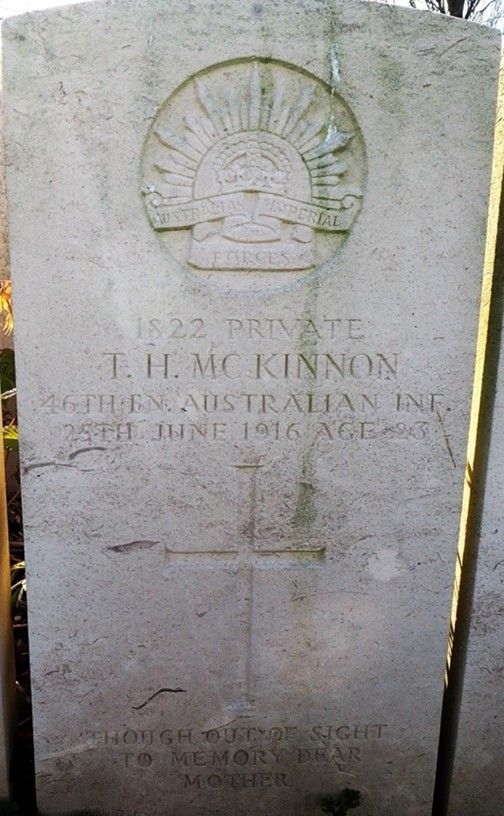
Hugh McQuat
Private, No. 4962
1st Battalion, 1st Infantry Brigade, 1st Australian Division
Died of wounds 16 March 1918, Hill 60, Ypres, Belgium
Buried Outtersteene Communal Cemetery Extension, Bailleul, France
"So he giveth his beloved sleep"
Harold Leslie Henley was born in 1893 and was the son of the Hon. Sir Thomas Henley KBE MLA, and Lady Charlotte Henley of Tudor House, College Street, Drummoyne. Leslie was a university student at the time of his enlistment, which occurred a week after war had been declared. Leslie first served with the ANMEF in German New Guinea, and on discharge, enlisted in the AIF. He was commissioned as a lieutenant and placed in command of the 7th Reinforcements to the 13th Battalion. He saw service on the Gallipoli peninsula and was promoted to captain after the evacuation. Leslie was involved in the 4th Division’s first action on the Western Front at Mouquet Farm, near Pozieres. He was killed by a high explosive shell while leading his company out of the line. He has no known grave and is commemorated at the Australian National Memorial, Villers-Bretonneux, France.
Harold Walter Marsh
Sapper, No. 3376
12th Field Company, Australian Engineers, 4th Australian Division
Killed in action 20 November 1916, Bernafay Wood, France
Buried Bernafay Wood British Cemetery, Montauban, France
"He gave his young life for his country’s cause & our freedom"
Harold Walter Marsh was 21 years old when he enlisted in August 1915. A plumber by occupation, Harold was assigned to the newly established 12th Field Company Engineers in Egypt. He saw service undertaking civil works in proximity to the front lines in the Somme and Ypres sectors of the Western Front. While undertaking works near Bernafay Wood in November 1916, Harold was killed by shell fire. He is buried in Bernafay Wood British Cemetery, Montauban, France.
AWM ID No. P09185.002 Studio portrait of members of the 13th Battalion who embarked from Sydney with the 11th Reinforcements aboard HMAT Port Lincoln on 13 October 1915. Identified back row, left to right: 3376 Private (Pte) Harold Walter Marsh.
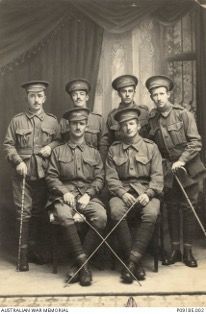
Frederick Miller
Private, No. 758
18th Battalion, 5th Infantry Brigade, 2nd Australian Division
Killed in action 5 October 1917, Zonnebeke, Belgium
Buried Railway Dugouts Burial Ground, Zillebeke, Belgium
"Transplanted human worth will bloom to profit otherwhere"
Frederick Miller was born in 1895 and was primarily connected with Balmain. Frederick enlisted in the AIF in August 1916 when his parents were living on Tranmere Street, Drummoyne. A horse driver by occupation, Frederick was initially assigned to the Cyclist Corps but was reassigned as a reinforcement to the 18th Battalion, which he joined in May 1917 in France. He saw action in the Third Battle of Ypres in the fighting on Menin Road and in the lead-up to the attack on Broodseinde Ridge when he was killed by a shell on 5 October 1917. Hurriedly buried by his comrades, Frederick’s remains were lost in subsequent fighting until found in 1924 and reburied in the Railway Dugouts Burial Ground, Zillebeke, Belgium.
Photograph of the headstone to the grave of Frederick Miller at Railway Dugouts Burial Ground (Transport Farm) at Zillebeke.
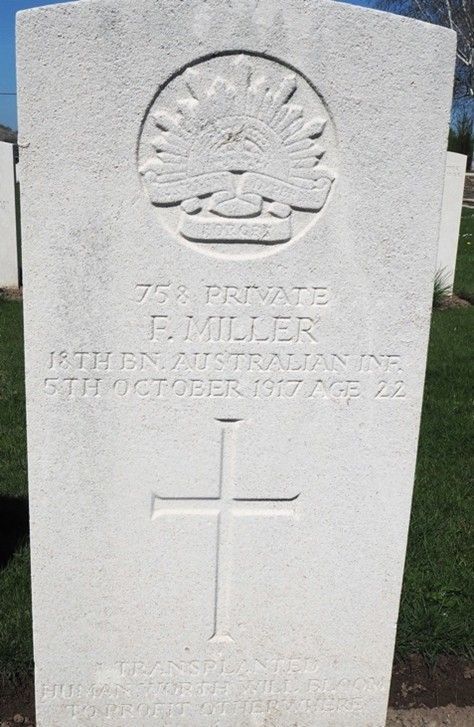
Harold Yabbicom Mortimore
Driver, No. 7240
4th Motor Transport Company, Australian Army Service Corps
Died of illness 26 November 1918
Buried Ste Marie Cemetery, Le Harve, France
"And when the trumpet calls hold fast my hand my son"
Harold Mortimore was the only son of Hugh and Elizabeth Mortimore. Harold enlisted in the AIF in June 1915 at the age of 22 when his family were living at 131 St Georges Crescent Drummoyne. An engineer by profession, Harold was appointed a Motor Driver and eventually served with the 2nd Divisional Ammunition Sub-Park and the 4th Divisional Motor Transport Company engaged in transporting troops and supplies from base depots to the forward lines. Harold survived the war but not the emerging pandemic that gripped the world in its aftermath. Harold died in hospital a fortnight after the war ended from influenza. Harold is buried at Ste Marie Cemetery, Le Harve, France.
Peter Bernard Joseph O’Reilly
Lieutenant
38th Battery, 10th Field Artillery Brigade, 4th Australian Division
Killed in action 3 May 1917, Bullecourt, France
No known grave. Commemorated Australian National Memorial, Villers-Bretonneux, France
Peter O’Reilly was born in Cobago, NSW, and enlisted within three weeks of the outbreak of the First World War at the age of 22. Peter would depart for overseas with one of the first troop convoys and see action at Gallipoli until evacuated sick. After a period of convalescing in England, he was posted to the Western Front and saw action at Ypres, Flers and ultimately Bullecourt, where he would be killed in May 1917 during a conspicuous display of bravery. Buried by men in his unit at Vaulx Cemetery, Peter’s grave was subsequently lost and his name is now included in the list of thousands of Australians with no known grave commemorated at the Australian National Memorial at Villers-Bretonneux.
Studio portrait of Peter O’Reilly - https://vwma.org.au/explore/people/160770
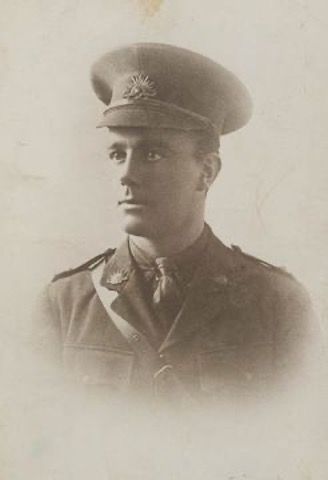
William Horace Parsons
Private, No. 4239
20th Battalion, 5th Infantry Brigade, 2nd Australian Division
Killed in action 2 May 1917, Bullecourt, France
No known grave. Commemorated Australian National Memorial, Villers-Bretonneux, France
William Horace Parsons was the son of William and Hannah Parsons who lived at 33 Park Avenue, Drummoyne. William was assigned to the 10th Reinforcements to the 20th Battalion when he enlisted in the AIF, eventually joining his unit in July 1916 in France. He was involved in the battles at Pozières and Mouquet Farm as part of the larger Somme offensive, and later in the year in the attack on Flers that ended the offensive. After seeing out the winter of 1916–17, William was involved in the pursuit of the Germans to the Hindenburg Line, and the successful repulse of the German attack on Lagnicourt. Shortly prior to the second attempt to take the fortified village of Bullecourt, William was killed by a shell burst while taking rations to the front lines. His body was either not recovered or lost. William is commemorated at the Australian National Memorial, Villers-Bretonneux, France.
Harold Kingsley Percival
Flight Cadet, No. 137709
Royal Air Force
Killed by accident 23 September 1918, Montrose, Scotland
Buried Sleepyhillock Cemetery, Montrose, Scotland
Harold Kingsley Percival was the eldest of seven children of Rev. George and Emily Percival. A school teacher by profession, Harold was not fit to enlist in the AIF and instead joined the YMCA and worked at various military camps around Sydney. In late 1916, when the family was living at Chalfort, Collingwood Street, Drummoyne, Harold left Australia to take up a position of field secretary for the YMCA at the AIF Depot in Westham, England where he worked for about 18 months. Harold’s fitness improved in the United Kingdom and he successfully enlisted in the Royal Air Force in March 1918. During his last training flight at Montrose Aerodrome on 23 September 1918 before heading to France, Harold’s plane crashed and he was killed instantaneously. Harold is buried at Sleepyhillock Cemetery, Montrose, Scotland.
Photograph of Harold Kingsley Percival. Source - University of Sydney http://beyond1914.sydney.edu.au/profile/3808/harold-kingsley-percival
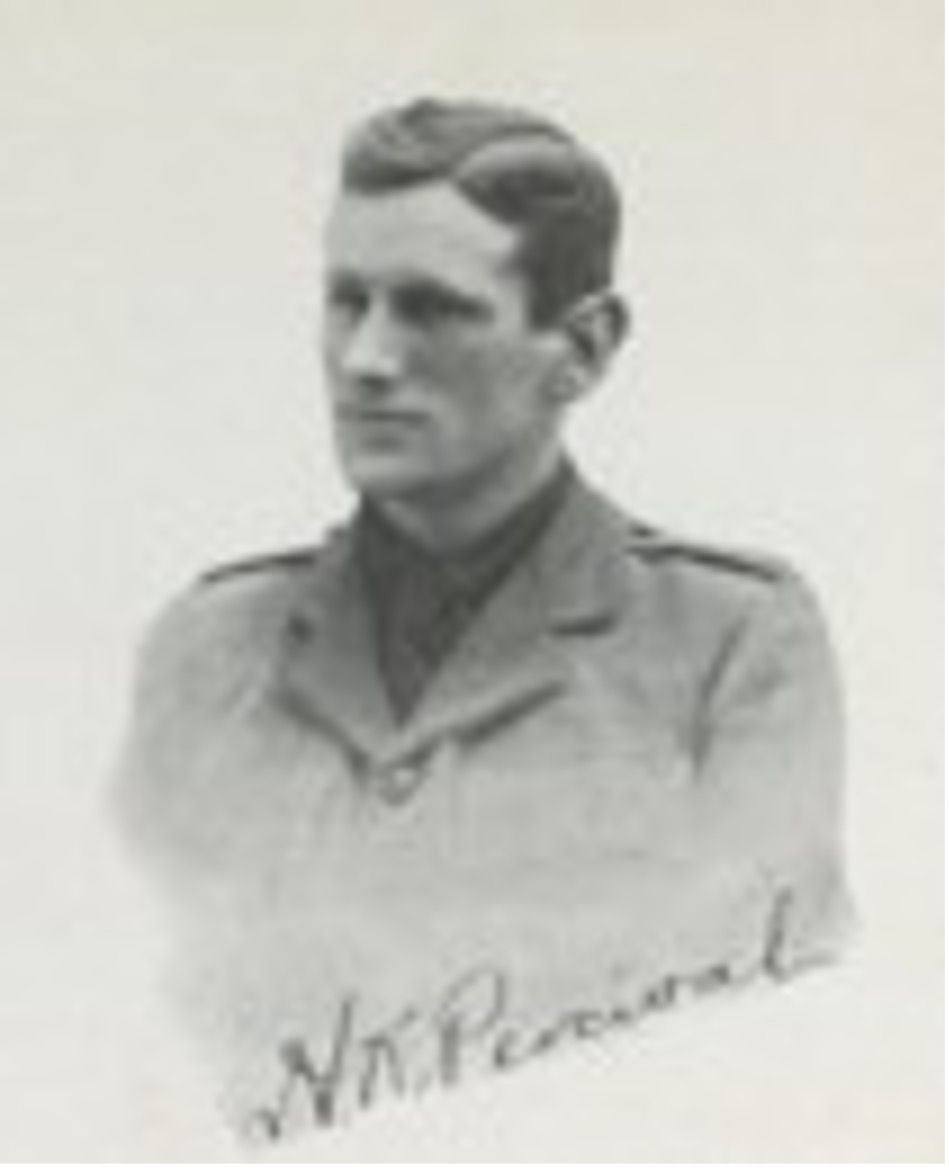
Claude Edward Pierpoint
Private, No. 6840
8th Battalion, 2nd Infantry Brigade, 1st Australian Division
Killed in action 16 April 1918, Hazebrouck, France
Buried Nieppe-Bois (Rue-Du-Bois) British Cemetery, Viserquin, France
Claude Pierpoint was born in Richmond, Victoria, in 1881 and raised by his sister Emily after his parents died during his infancy. Nothing is known of Claude’s early life or education, but by the time he first came to enlist in the AIF in November 1915 in Armidale, NSW, Claude was working as a labourer and a cook. He was assigned to the 22nd Reinforcements to the 8th Battalion, which he joined in early 1917. Claude was engaged in fighting around the Hindenburg Line after the Battle of Bullecourt before joining in the attack on Menin Road as part of the Third Battle of Ypres later that year. Wounded in the fighting and evacuated to England, he returned to Belgium in February the following year. It was during the fighting near the village of Hazebrouck in April 1918 that Claude was killed in action. He is buried Nieppe-Bois (Rue-Du-Bois) British Cemetery, Viserquin, France.
Photograph of the headstone of the grave of Claude Pierpoint at Nieppe-Bois (Rue-Du-Bois) British Cemetery, Vieux-Berquin.

Alfred William Potiphar
Driver, No. 154
36th Battalion, 9th Infantry Brigade, 3rd Australian Division
Killed in action 22 July 1917, Messines, Belgium
Buried Kandahar Farm Cemetery, Neuve-Eglise, Belgium
Alfred William Potiphar was born in England in about 1881 and had served with the Royal Field Artillery. Alfred emigrated to Australia before the outbreak of the war. Prior to his enlistment in January 1916, he married Ellinor Spring, who would have a daughter after Alfred had embarked for service overseas. As a driver assigned to the 36th Battalion transport with the 3rd Division, Alfred arrived in France at the end of 1916. After a period on the Somme, he moved to Belgium in April 1917 with his battalion and took part in the Battle of Messines in June 1917. Alfred was killed in unknown circumstances on 22 July 1917 while at Messines. He is buried in Kandahar Farm Cemetery, Neuve-Eglise, Belgium.
Photograph of Alfred Potiphar – source: Sunday Times (Sydney), Sun 10 Jun 1917 Page 3
https://trove.nla.gov.au/newspaper/page/13214734

Andrew Price
Corporal, No. 798
3 rd Battalion, 1 st Infantry Brigade, 1 st Australian Division
Killed in action 29 April 1915, Gallipoli
No known grave. Commemorated at Lone Pine Memorial, Gallipoli, Turkey
Andrew Price was born in Shrewsbury, England, and had served with the Royal Marines before emigrating to Australia. Andrew married his wife Eugenie in Sydney in 1895 and saw further service with the New South Wales Naval Contingent during the Boxer Rebellion in China in 1900–1901. On his return, Eugenie had a son, Andrew Edmond Price, in 1902. Andrew enlisted within a month of the outbreak of the war in September 1914 and was assigned to the 3rd Infantry Battalion. He was involved in the initial landings at ANZAC Cove on 25 April 1915. During the fierce fighting and confusion that immediately followed the landings, Andrew was killed on 29 April when he was shot through the heart while his battalion was being relieved at Quinn’s Post. Although he was reported to have been buried near where he was killed, his body was never recovered or identified, and he is commemorated at the Lone Pine Memorial.
Thomas Charles Price
Private, No. 5464
18th Battalion, 5th Infantry Brigade, 2nd Australian Division
Killed in action, Menin Road, Belgium, 20 September 1917
Buried, Hooge Crater Cemetery, Zillebeke, Belgium
Thomas Price was a native of London, England, but had emigrated to Australia with his parents who established their family in Drummoyne. At the age of 29, Thomas enlisted in the AIF and was assigned as a reinforcement to the 18th Battalion. After training in England, Thomas joined his battalion in early 1917, but suffered a number of bouts of illness including a fever, which prevented him from participating in the fighting at Bullecourt in May 1917. He rejoined his unit just as it began to move to Belgian Flanders in anticipation of being thrown into the next phase of the Third Battle of Ypres. Thomas was killed in the attack on Menin Road Ridge on 20 September 1917 in unknown circumstances. His grave was recovered in 1920 and his remains reburied at Hooge Crater Cemetery, Zillebeke, Belgium.
Photograph of the headstone of the grave of Thomas Price, Hooge Crater Cemetery, Zillebeke.

Arvan James Prichard
Lieutenant
22nd Machine Gun Company, 2nd Australian Division
Killed in action 18 July 1918, Villers-Bretonneux, France
No known grave. Commemorated Australian National Memorial, Villers-Bretonneux, France
Arvan James Prichard was born in Townsville, Queensland, in 1898. Prior to his enlistment, the Prichard family had moved to New South Wales with his family and lived at ‘Wyee’, 17 Havelock Street, Drummoyne. At the age of 18 years, he enlisted with the qualified consent of his parents, William Gordon Prichard and Catherine Prichard. Arvan initially saw action in the final months of the Gallipoli campaign with the 20th Battalion and transferred to the 5th Machine Gun Company after joining the BEF in France. Commissioned as a lieutenant with the 22nd Machine Gun Company, Arvan spent a period as an instructor at the Australian Machine Gun Training School at Grantham, England, before rejoining his unit in March 1918. He was killed in action outside Villers-Bretonneux on 18 July 1918. Although buried by his comrades and his grave marked with a cross, his remains could not be located after the war. Arvan is commemorated at the Australian National Memorial, Villers-Bretonneux, France.
Studio portrait of 1383 Private (Pte) Arvan James Prichard, 20th Battalion, made Sydney c. 1916 [sic], Sydney Mail. AWM ID number P05301.081. Public domain.

Harry Lansbury Urquhart Reid
Private, No. 456
2nd Battalion, 1st Infantry Brigade, 1st Australian Division
Killed in action 2 May 1915, Gallipoli
No known grave. Commemorated at Lone Pine Memorial, Gallipoli, Turkey
Harry Reid was born in Brisbane in 1890 but moved to Sydney where he undertook secondary schooling and attended the University of Sydney. While employed as a clerk with the Department of Lands, Harry enlisted in the AIF shortly after the outbreak of the war and sailed with the first contingent towards the end of 1914. Harry was part of the second wave of men that landed on ANZAC Cove beaches on the morning of 25 April 1915 and was likely involved in fierce fighting during the confusion of the initial landings. Reports are conflicted as to when Harry was killed. Although reported to have been buried close to where he fell, his body was never recovered, and Harry is commemorated at the Lone Pine Memorial, Gallipoli.
Photo from 1915 'HEROES, OF THE DARDANELLES.', The Daily Telegraph (Sydney, NSW: 1883-1930), 10 July, p. 1 , viewed 19 Oct 2022,
http://nla.gov.au/nla.news-article238915145; 1915 'HEROES OF THE DARDANELLES.', The Sydney Morning Herald (NSW: 1842-1954), 13 July, p. 5. , viewed 23 Oct 2022,
http://nla.gov.au/nla.news-article15593186
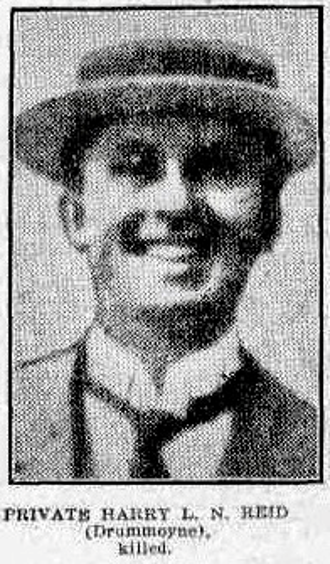
Frank Richardson
Private, No. 3824
1st Battalion, 1st Infantry Brigade, 1st Australian Division
Killed in action 22–25 July 1916, Pozieres, France
No known grave. Commemorated at Australian National Memorial, Villers-Bretonneux, France
Frank Richardson was just 18 years old when he enlisted to join the AIF in September 1915. The only son of James and Amy Richardson, Frank was working as a sailmaker and living at Forest Lodge when he enlisted. Assigned as a reinforcement to the 1st Battalion, Frank was killed in his first major action at Pozieres as part of the Somme Offensive in 1916. He is thought to have been killed by a shell explosion sometime between 22–25 July 1916 and was buried close to where he died. His body however was never located, and he has no known grave. Frank is commemorated at the Australian National Memorial, Villers-Bretonneux, France.
AWM ID No. P08133.002. Studio portrait of Frank Richardson of Forest Lodge, NSW. Frank was a 2nd Lieutenant in the Senior Cadets attached to the 29th Infantry Regiment (Australian Rifles). Right: AWM ID No. P08133.001. Studio portrait of 3824 Private (Pte) Frank Richardson, 1st Battalion, of Forest Lodge, NSW. C.1915.

Kenneth Robertson
Corporal, No. 803
3rd Battalion, 1st Infantry Brigade, 1st Australian Division
Killed in action 25 June 1915, Gallipoli
Buried Shrapnel Valley Cemetery, Gallipoli, Turkey
Kenneth Robertson was born in 1895 to John and Maggie Robertson and worked as a shipwright at Morrison & Sinclair in Balmain. Living with his parents at 59 St Georges Crescent, Drummoyne, Kenneth enlisted within three weeks of the outbreak of war in 1914. Assigned to the newly formed 3rd Battalion, Kenneth was promoted to corporal on account of his previous militia service and sailed with the first contingent of the AIF in October 1914. Kenneth landed at ANZAC Cove on 25 April 1915 as part of the second wave and was involved in the heavy fighting both of the initial landings and subsequent Turkish counter-attacks. Kenneth was killed in action on 25 June 1915 at the age of 19. He is buried at Shrapnel Valley Cemetery, Gallipoli.
Photograph of Kenneth Robertson source - The Daily Telegraph (Sydney, NSW: 1883-1930), p. 11. Retrieved June 25, 2022, from
http://nla.gov.au/nla.news-article238919946

Frederick Charles Robinson
Private, No. 2196
18th Battalion, 5th Infantry Brigade, 2nd Australian Division
Killed in action 4 August 1916, Pozières, France
No known grave. Commemorated at Australian National Memorial, Villers-Bretonneux, France
Frederick Charles Robinson was born in 1895 near Coffs Harbour. In 1915 at the age of 19 he married May Robinson and in the same year enlisted in the AIF with his brother, Albert Francis. Assigned to reinforcements to the 18th Battalion, Frederick trained briefly in Egypt before travelling to France where he participated in a trench raid near Bois Grenier. The 2nd Division was transferred to the Somme sector of the Western Front in late July 1916 and eventually relieved units of the 1st Division in the fighting at Pozieres. After the 18th Battalion’s attack on German trenches on 4 August, Frederick and another man were sent out on patrol. Frederick was never seen again and is presumed to have been killed in action. Frederick has no known grave and is commemorated at the Australian National Memorial, Villers-Bretonneux, France.
Robert Melville Robinson
Private, No. 756
18th Battalion, 5th Infantry Brigade, 2nd Australian Division
Killed in action 27 August 1915, Gallipoli
No known grave. Commemorated at Lone Pine Memorial, Gallipoli, Turkey
Robert (Bob) Robinson was born in Balmain but was raised and educated in Drummoyne. An engineer by profession, he enlisted in the AIF in May 1915 leaving behind his parents Charles and Catherine Robinson and sister Florence, then living at 2 Broughton Street. Bob embarked shortly after enlistment as part of the newly formed 18th Battalion and within a brief period of time found himself committed to the last great offensive of the Gallipoli campaign. Landing with the battalion on 22 August, the battalion was immediately committed to renew an attack on Hill 60, which had failed to be taken by experienced ANZAC troops. The battalion suffered heavy losses with Bob being among them. Although Bob’s body was recovered by a search party at the end of October 1915 and buried, his grave could not be located, and he is commemorated at the Lone Pine Memorial.
William Ruffley
Armourer Sergeant, No. 1539
47th Battalion, 12th Infantry Brigade, 4th Australian Division
Killed in action 13 October 1917, Passchendaele, Belgium
No known grave. Commemorated The Ypres Menin Gate Memorial, Ypres, Belgium
William Ruffley was born in St Peters NSW in 1889. He enlisted in December 1914 and was assigned as part of the reinforcements to the 15th Battalion. William saw action from the landing on Gallipoli peninsula until September 1915 when he was evacuated to England. After a period in hospital, William returned to Egypt and was transferred to the 47th Battalion as part of the doubling of the AIF. He saw action at Pozieres but in early 1917 was again evacuated to hospital. William missed the first Battle of Bullecourt in April 1917 but secured leave to London where he married Dorothy Alice Wren. He was involved in the subsequent fighting at Messines Ridge, Menin Road and the attack on Passchendaele Ridge. It was in this last attack that William was killed although no information regarding the circumstances of his death is known. William has no known grave and is commemorated at The Ypres Menin Gate Memorial, Ypres, Belgium.
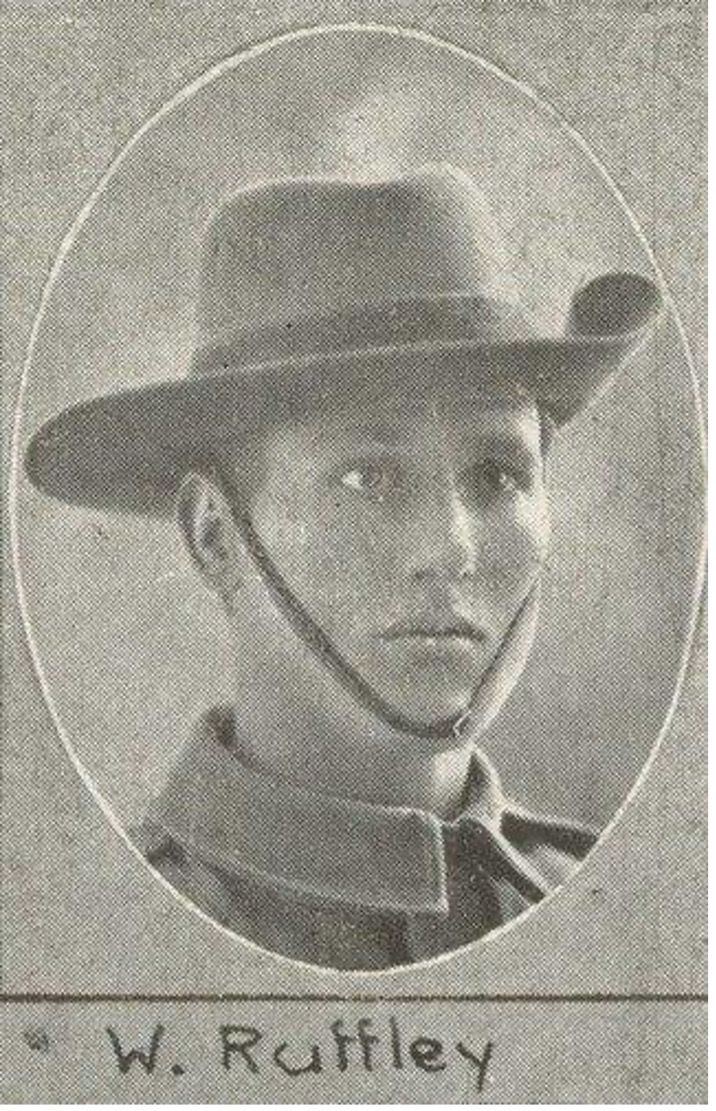
George Columbus Ryng
Gunner, No. 1222
10th Field Artillery Brigade, 4th Australian Division
Killed in action 8 June 1917, Messines, Belgium
No known grave. Commemorated the Ypres (Menin Gate) Memorial, Ypres, Belgium
George Columbus Ryng was born in Hunters Hill in 1893 and was one of seven children to James and Susannah Ryng. His parents died while he was young, and by the time of his enlistment in the AIF in October 1914, George was employed as a carter. He enlisted as a private and was assigned to the 13th Battalion, which landed at ANZAC Cove as part of the initial landings on 25 April 1915. George was wounded on 13 May and evacuated to Egypt and did not rejoin his unit until after Australian forces had been evacuated from Gallipoli. George transferred to the 10th Field Artillery Brigade and saw action at Fromelles and Ypres in 1916 but was evacuated to hospital on a number of occasions in early 1917 before rejoining his unit in time to support the attack on Messines in June 1917. He was killed in action during the battle on 8 June 1917 and has no known grave. George is commemorated on the Ypres (Menin Gate) Memorial, Ypres, Belgium.
Spencer Stanley Seale
Private, No. 3223
3rd Battalion, 1st Infantry Brigade, 1st Australian Division
Killed in action 5 May 1917, Bullecourt, France
No known grave. Commemorated Australian National Memorial, Villers-Bretonneux, France
Spencer Stanley Seale was born in 1891 in the Parish of Leichhardt but lived most of his life around Thirroul. A warehouseman by trade, he enlisted in the AIF in August 1915 with his brother Harold. Originally assigned to the 18th Battalion, on arrival in Egypt the brothers were transferred to reinforce the 3rd Battalion. They saw action on the Somme with Harold badly wounded at Pozières. Spencer was also evacuated to hospital in August 1916 for an extended period, only re-joining the battalion just prior to the Battle of Bullecourt. He was badly wounded on 5 May 1917 when a shell exploded in his trench. Due to the fighting, he could not be evacuated and died shortly after. The trench was subsequently lost, and Spencer has no known grave. He is commemorated on the Australian National Memorial, Villers-Bretonneux, France
Ernest Shannon
Lieutenant
34th Battalion, 9th Infantry Brigade, 3rd Australian Division
Killed in action 1 June 1917, Ploegsteert, Belgium
Buried Strand Military Cemetery, Ploegsteert, Belgium
"Dearest Ernest our beloved son and brother gave his life for us"
Ernest Shannon was born in 1890 in Wagga Wagga where he attended the local high school. After graduating from Teachers Training College in Sydney, Ernest commenced teaching at Drummoyne Public School. While also enrolled at the University of Sydney in an Arts degree, he joined the AIF in November 1915 and was appointed a second lieutenant in the newly established 34th Battalion as part of the 3rd Australian Division. After a period of training in England, Ernest saw service in the Armentieres sector of the Western Front. During a final trench raid before the launch of Battle of Messines in June 1917, Ernest was killed in action. He is buried in Strand Military Cemetery, Ploegsteert, Belgium.
Studio portrait of Ernest Shannon from
https://harrowercollection.com.au/category/pre-world-war-one-new-south-wales/26th-infantry-regiment/ (accessed 22 April 2023). Above right: Photograph of Ernest Shannon and
https://canadabayheritage.asn.au/a-last-goodbye/ (accessed 22 April 2023).
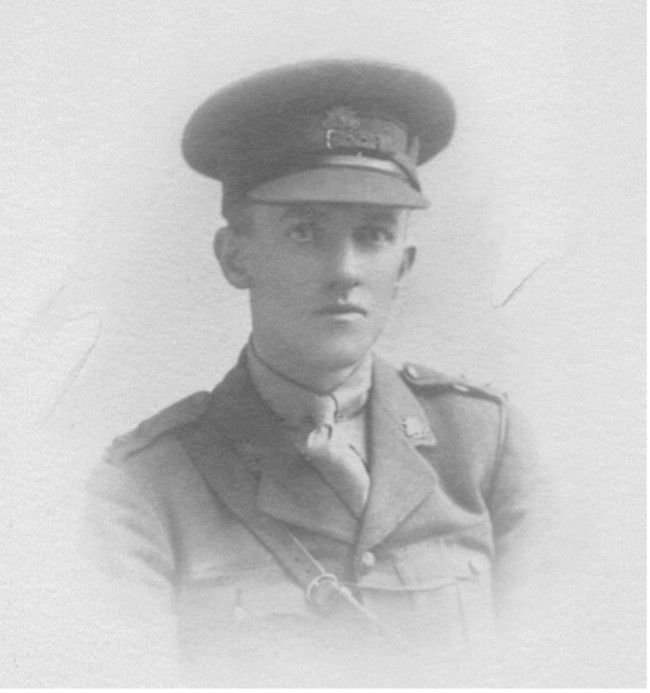
Samuel Shimmin
Private, No. 4592
2nd Battalion, 1st Infantry Brigade, 1st Australian Division
Died of wounds 5 May 1917, Bullecourt, France
Buried Grevillers British Cemetery, France
"Greater love hath no man than to lay down his life for his friends"
Samuel Shimmin was born in 1890 on the Isle of Man and emigrated to Australia in about 1910. Employed as a shop assistant and living at 10 Tranmere Street, Drummoyne, at the time of his enlistment in September 1915, Samuel was assigned to the 14th Reinforcements to the 2nd Battalion. Samuel joined his battalion in May 1916 in France and saw his first major action at Pozières where he was evacuated suffering from shell shock. Samuel experienced the severe winter of 1916–1917 on the Somme before being involved in the follow up of the Germans after their withdrawal to the Hindenburg Line. He fought in the Second Battle of Bullecourt in May 1917 during which he was severely wounded and evacuated to a CCS where he died from his wounds. Samuel is buried in Grevillers British Cemetery, France.
Photograph of the headstone of the grave of Samuel Shimmin, Grevillers British Cemetery.
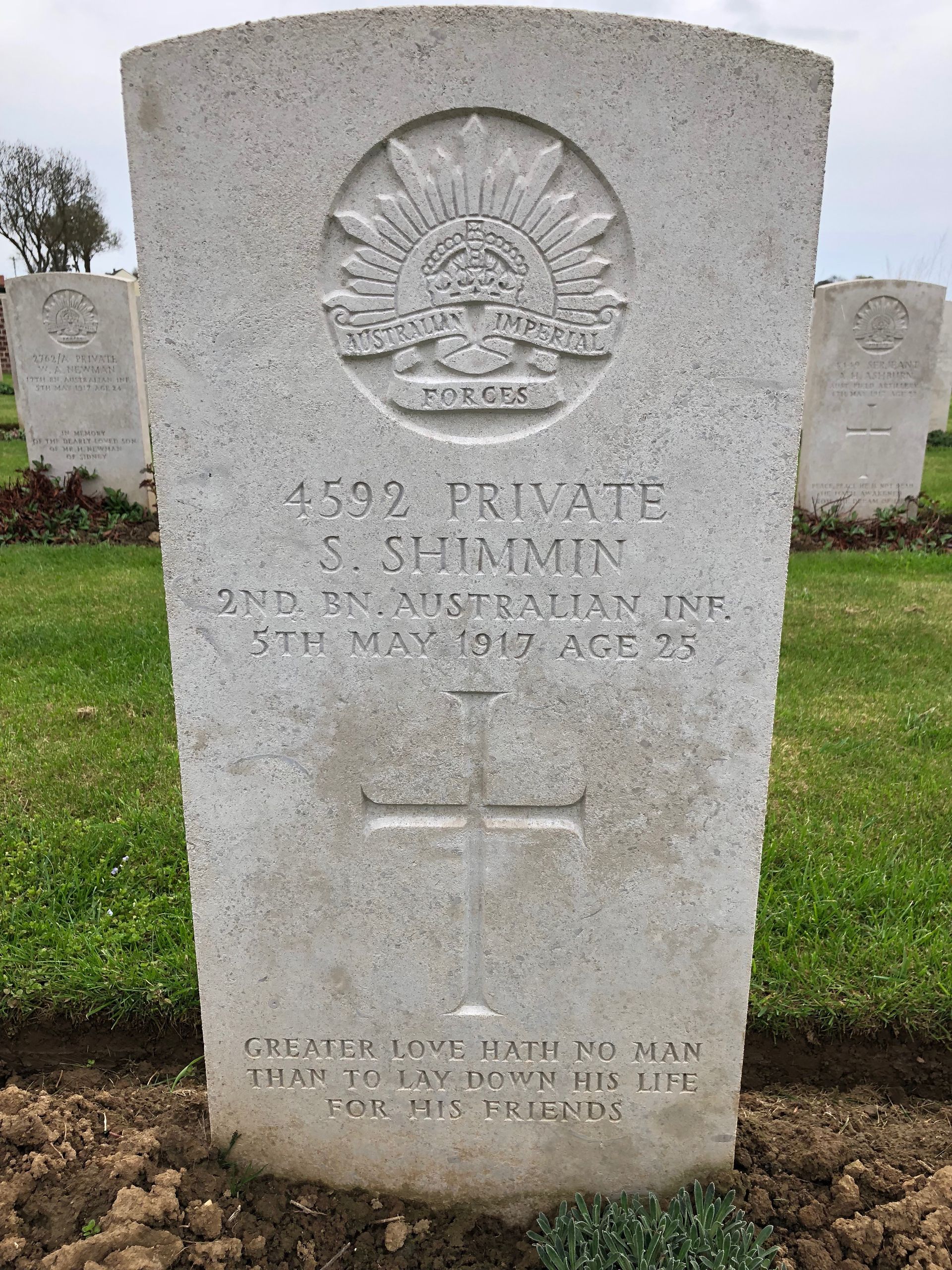
Bert Arthur Simpson
Private, No. 170
36th Battalion, 9th Infantry Brigade, 3rd Australian Division
Killed in action 12 October 1917, Passchendaele, Belgium
Buried Tyne Cot Cemetery, Passchendaele, Belgium
"In the Garden of Sleep Where the Poppies Bloom"
Bert Arthur Simpson was born in 1889. A travelling salesman, Bert was living at 25 Havelock Street, Drummoyne, when he enlisted in the AIF in December 1915 at the age of 26. Assigned to the newly formed 36th Battalion, he sailed with the 3rd Australian Division for England in May 1916. The battalion did not arrive on the Western Front until late 1916 where it experienced a severe winter. It was late in that season that Bert suffered a severe knee injury, resulting in him being evacuated to England. Bert’s injury kept him out of the fighting for much of 1917. He finally returned to his battalion in late September 1917 during the height of the Third Battle of Ypres. Less than two weeks after returning, Bert was killed in action during the attack on Passchendaele Ridge. His remains were exhumed after the war and reburied in Tyne Cot Cemetery.
ANOTHER AUSTRALIAN WINS THE VICTORIA CROSS (1917, July 15). Sunday Times (Sydney, NSW: 1895-1930), p. 22. Retrieved April 29, 2023, from
http://nla.gov.au/nla.news-article122792111
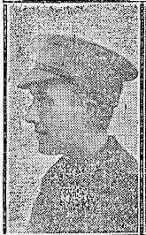
James Slater
Private, No. 2980
59th Battalion, 15th Infantry Brigade, 5th Australian Division
Killed in action 11 May 1917, Bullecourt, France
Buried Queant Road Cemetery, Buissy, France
"In God’s Keeping and We Shall Meet Again"
James Slater was born in 1887 in the Shetland Islands, Scotland. The eldest of seven children, he emigrated to Australia in about 1910-1911 and worked as a clerk before enlisting in the AIF in late 1916. Giving his address as ‘Adela’ Lenore Street, Five Dock, James was assigned to the 7th Reinforcements to the 59th Battalion, joining his unit in late March 1917 as it was involved in outpost fighting following the German withdrawal to the Hindenburg Line. Although the battalion was spared assaulting the Hindenburg Line, including the two Battles of Bullecourt, it was committed to defending the gains and it was during this fighting that James was killed in action on either 11 or 12 May, most probably by a German shell. James’ remains were exhumed after the war and reburied in Queant Road Cemetery, Buissy, France.
Photograph of the headstone of the grave of James Slater, Queant Road Cemetery, Buissy.
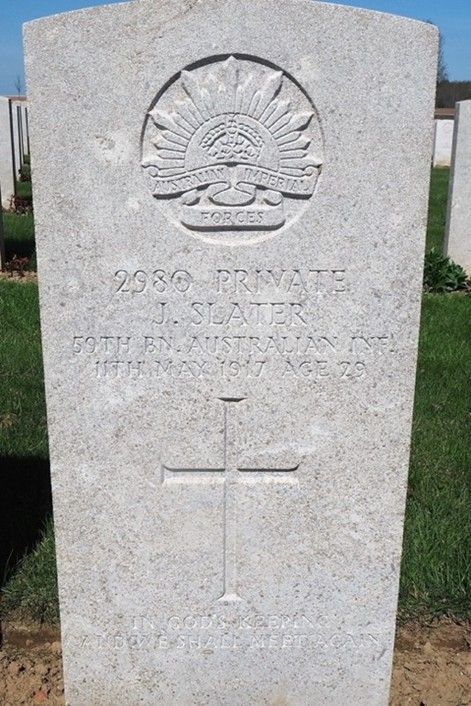
Robert Alexander Smith
Private, No 7325
2nd Battalion, 1st Infantry Brigade, 1st Australian Division
Died of wounds, 13 April 1918, Namps-au-Val, France
Buried Namps-au-Val British Cemetery, Amiens, France
Robert Alexander Smith was born in 1885 in Crudine, NSW. Robert enlisted in the AIF in November 1916 and was assigned to the 24th Reinforcements to the 2nd Battalion. After an extended period of training in England, Robert finally joined the 2nd Battalion in October 1917 just as it was about to rejoin the fighting in the Third Battle of Ypres. He was evacuated to hospital in January 1918, which kept him out of action until early April 1918 just as the battalion was being transferred to the Somme sector in France to meet the German Spring offensive. While at St Roche railway station near Amiens, Robert was severely wounded on 11 April 1918 by German shelling. He died of his wounds on 13 April 1918 and was buried in the nearby Namps-au-Val British Cemetery, Amiens.
Australian troops of the 1st Division enjoying a well-earned spell in the vaults beneath the ramparts of Ypres, in Belgium. 7325 Pte Robert Alexander Smith (right foreground, sitting). 1 November 1917. AWM ID No. E01399. Public domain.
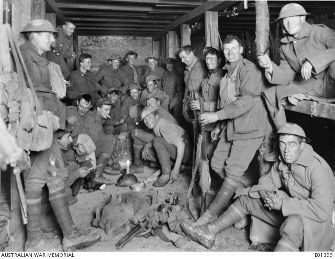
Clarence James Sommerville
Lance Corporal, No. 2491
1st Machine Gun Company, 1st Brigade, 1st Australian Division
Died of wounds 12 November 1916, Flers, France
Buried Bernafay Wood British Cemetery, Montauban, France
Clarence James (Jim) Sommerville was born in about 1892 and spent part of his early life on the NSW mid-coast. Clarence returned to Sydney prior to his enlistment in the AIF in May 1915 naming his father Thomas living at 11 Plunkett Street, Drummoyne, as his next of kin. Clarence was assigned as a reinforcement to the 1st Battalion and joined his unit at Gallipoli during the last stages of that campaign. After evacuation to Egypt, Clarence was transferred to the newly established 1st Machine Gun Company in the 1st Brigade, and saw action at Pozières, Mouquet Farm and also briefly in the Ypres salient. In October 1916, the brigade had returned to the Somme for winter and it was during fighting around Flers in November 1916 that Clarence was mortally wounded by a direct hit from a German shell on his dugout. He died shortly after being evacuated at the 2nd Australian Field Ambulance and was buried in Bernafay Wood British Cemetery, Montauban, France.
Headstone of Clarence Sommerville at Bernafay Wood British Cemetery.
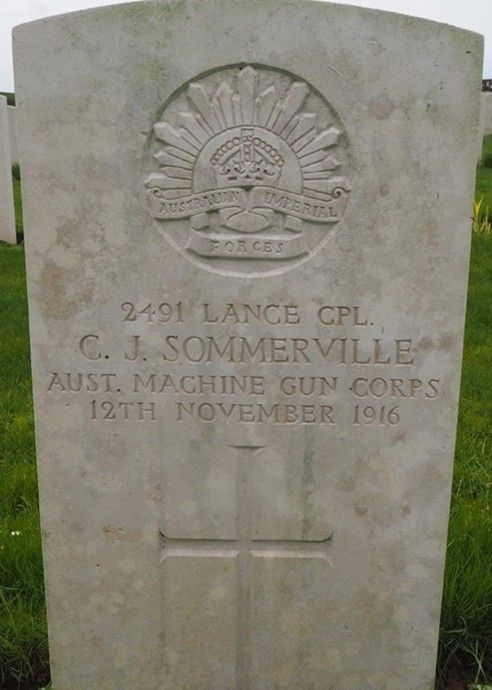
William Spring
Private, No. 5175
13th Battalion, 4th Brigade, 4th Australian Division
Killed in action 11 April 1917, Bullecourt, France
No Known Grave. Commemorated Australian National Memorial, Villers-Bretonneux, France
William Spring was born in 1898 to Arthur and Elizabeth Spring who lived at Hazeldene, 103 Renwick Street, Drummoyne. William successfully enlisted on his eleventh attempt in January 1916 at the age of 18 and was assigned as a reinforcement to the 13th Battalion. He arrived in France and joined his battalion in July 1916 just before the 4th Division’s first major engagement at Pozières and Mouquet Farm. William survived the Somme offensive of 1916 but in early 1917 was evacuated to hospital suffering from trench foot. He re-joined his battalion in March 1917 just prior to its next major engagement, the First Battle of Bullecourt. On 11 April 1917, William was wounded during the fighting and while returning across no-man’s land to the Australian lines was killed. His body was not recovered, and he has no know grave. William is commemorated on the Australian National Memorial, Villers-Bretonneux, France.

Clive Townsend Thompson
Driver, No. 30183
38th Battery, 10th Field Artillery Brigade, 4th Australian Division
Killed in action 8 October 1917, Passchendaele, Belgium
Buried Ypres Town Cemetery Extension, Menin Gate, Belgium
Clive Townsend Thompson was born in 1897 and lived at 17 Collingwood Street, Drummoyne. Clive attended Sydney Grammar School and Bathurst Government Farm studying agriculture when he applied to enlist in the AIF at the age of 19 in September 1916. Initially assigned as a reinforcement to the 1st Field Artillery Brigade, on arrival on the Western Front, he was taken on strength with the 10th Field Artillery Brigade, which at the time was involved in the initial stages of the Third Ypres offensive. Clive was involved in the fighting for Menin Road and Broodseinde Ridges, and it was during the fighting that Clive was killed in action on 8 October 1917. His body was exhumed after the war and reburied in Ypres Town Cemetery Extension.
Studio portrait of 30183 Driver Clive Townsend Thompson, 10th Australian Field Artillery Brigade (FAB) from Drummoyne, NSW. AWM ID No. H06533.
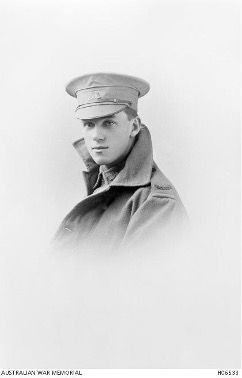
Charles Leslie Thornton
Private, No 10089
14th Australian Field Ambulance, 5th Australian Division
Killed in action, 21 September 1917, Polygon Wood, Belgium
Buried Hooge Crater Cemetery, Zillebeke, Belgium
"He Died the Noblest Death Man May Die for God, Right and Liberty"
Charles Thornton was born in 1895 and lived with his parents Sydney and Sarah Thornton on Bridge Road, Drummoyne, at the time he enlisted with his brother Mervyn in 1915. The brothers were assigned as reinforcements to the 8th Field Ambulance but on arrival in France in July 1916, they were both transferred to the 14th Field Ambulance where they became stretcher bearers. The brother served during the latter stages of the Somme offensive, and at the Second Battle of Bullecourt in May 1917. During the fighting at Polygon Wood in September 1917 during the Third Battle of Ypres, Charles was killed in action in unknown circumstances. Charles is buried at Hooge Crater Cemetery, Zillebeke, Belgium.
Photograph of the headstone of the grave of Charles Thornton at Hooge Crater Cemetery, Zillebeke, Belgium.

Mervyn Willoughby Thornton
Private, No 10088
14th Australian Field Ambulance, 5th Australian Division
Died of illness 30 October 1918, Harewood, United Kingdom
Buried Harefield (St Mary) Churchyard, Middlesex
When God Saw His Work Below Was Done He Gently Called Him “My Son”
Mervyn Thornton was born in 1894 and lived with his parents Sydney and Sarah Thornton on Bridge Road, Drummoyne at the time of his enlistment along with his brother Charles in 1915. The brothers were assigned as reinforcements to the 8th Field Ambulance but on arrival in France in July 1916, they were both transferred to the 14th Field Ambulance where they became stretcher bearers. Charles and Mervyn served during the latter stages of the Somme offensive, and at the second battle of Bullecourt in May 1917. During the fighting at Polygon Wood in September 1917 during the Third Battle of Ypres, Charles was killed in action in unknown circumstances. Mervyn continued to serve with the 14th Field Ambulance and was involved in the desperate fighting outside of Amiens to stop the German spring offensive, the fighting around Villers-Bretonneux in April 1918 and the follow up Allied offensives. Mervyn was granted leave in early October to the UK and it was while there that he was admitted to hospital suffering from pneumonia and died on 30 October 1918, less than two weeks before the Armistice.
Photograph of the grave of Mervyn Thornton. Source -
https://ww1austburialsuk.weebly.com/o---w.html (reproduced with permission).

Russell Stewart Thornton
Private, No. 1204
2nd Battalion, 1st Infantry Brigade, 1st Australian Division
Killed in action 20 May 1915, ANZAC Cove
Buried Lone Pine Cemetery, Gallipoli, Turkey
Russell Stewart Thornton was born in 1890, one of four sons of Harry and Emily Thornton. In 1914, Russell was living with his uncle on Bridge Road, Drummoyne, when he enlisted in the AIF. Russell joined the 2nd Battalion in Egypt in February 1915 and was part of the initial waves that landed on ANZAC Cove on 25 April. Involved in the desperate fighting that followed, Russell was killed in action sometime on 20 May 1915 when the battalion was involved in repulsing the first major Turkish attack on the ANZAC Cove beachhead. Russell was initially buried in Victoria Gully but his remains were exhumed after the war and ultimately reinterred at Lone Pine Cemetery in 1926.

Alfred Richard Toogood
Private, No. 5648
17th Battalion, 5th Infantry Brigade, 2nd Australian Division
Died of illness, Perth, Western Australia, 25 September 1916
Buried Karrakatta Cemetery, Western Australia
Alfred Toogood was born in 1878, the third child and only son of Sydney and Louisa Toogood. An accountant at the time of his enlistment in the AIF in March 1916, Alfred was assigned to the 15th reinforcements to the 17th Battalion. Alfred embarked from Sydney in September 1916 for overseas service but was disembarked sick at Fremantle suffering from meningitis. Alfred was transferred to the West Subiaco Hospital where he died less than a week later. He is buried in Karrakatta Cemetery, Perth, Western Australia.
Photograph of the grave of Alfred Toogood, Karrakatta Cemetery, Perth, Western Australia (courtesy Western Australia Metropolitan Cemeteries Board).

Arthur James Vincent
Corporal, No. 2163A
37th Battalion, 10th Infantry Brigade, 3rd Australian Division
Killed in action 8 June 1917, Messines, Belgium
No known grave. Commemorated Ypres (Menin Gate) Memorial, Ypres, Belgium
Arthur James Vincent was born in Wangaratta in 1879. In 1902, he enlisted and served in the final stages of the Boer War before returning to Australia. After spending time undertaking labouring jobs in New Zealand and NSW, Arthur married Alice Matilda Dewsbury at St Bede’s Anglican Church, Drummoyne, in January 1914 before returning to his home town where Arthur and Alice’s only child, Jean Isabel Mary, was born in 1915. In 1916 at the age of 37, Arthur enlisted in the AIF and was assigned to his brother George’s battalion, the 37th. Arthur joined the battalion and his brother in February 1917. His first major action, the attack on Messines Ridge in Belgium in June 1917, would be his last as on 8 June 1917, he was reported as killed in action. Although reported to have been buried close to where he fell, his grave was lost in subsequent fighting, and Arthur is commemorated on the Menin Gate Memorial in Ypres.
Thomas Smith Virtue
Private, No. 478
1st Battalion, 1st Infantry Brigade, 1st Australian Division
Died of illness, 9 December 1916
Buried Glasgow Western Necropolis, Scotland
"With Jesus Which is far better"
Thomas Smith Virtue was born in Glasgow, Scotland and emigrated to Australia at the age of 17 in about 1908. Employed as an ironworker, Thomas enlisted in the AIF in late August 1914 and was assigned to the 1st Infantry Battalion. He sailed with the first contingent of the AIF in October 1914, and after a period of training in Egypt, landed as part of the second wave at ANZAC Cove on 25 April 1915. Thomas was wounded in the arm during the first days of fighting and evacuated to hospital in Egypt. He returned to Gallipoli in late July in time to join the fighting at Lone Pine where Thomas was again wounded and evacuated to Egypt. In and out of hospital and trouble with the law, Thomas travelled to France and was assigned to duties at the 1st Australian Division Base Depot. He died on 9 December 1916 from severe pneumonia while on leave at the 3rd Scottish General Hospital, Stobhill, Glasgow. Thomas is buried in the Glasgow Western Necropolis, Scotland.
Photograph of Private Thomas Smith Virtue -
https://ww1austburialsuk.weebly.com/uploads/4/9/7/8/4978039/virtue__thomas_smith.pdfn (with permission).
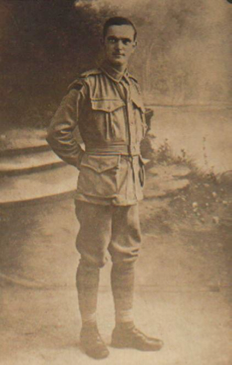
John Walker
Gunner, No. 35672
4th Field Artillery Brigade, 2nd Australian Division
Killed in action 5 October 1918, Montbrehain, France
Buried Roisel Communal Cemetery Extension, Roisel, France
John Walker was born in North Elgin, Scotland in 1884, and emigrated to Australia shortly before the outbreak of the war in 1914. John enlisted in the AIF in January 1917 while living at Lyons Road, Drummoyne, and was assigned as a reinforcement to the Australian Field Artillery. After a period of training in the UK, John joined the 11th Battery to the 4th Australian Field Artillery Brigade in November 1917 after the conclusion of the Third Battle of Ypres. John served with the Brigade in Belgium until it was transferred to the Somme sector in France in response to the German Spring offensive. The Brigade was in almost constant action until October 1918, and it was during one of its last major actions that John was reported killed in action on 5 October 1918 outside of Montbrehain. John is buried in Roisel Communal Cemetery Extension, Roisel, France.
Photograph of the grave of John Walker, Roisel Communal Cemetery Extension.
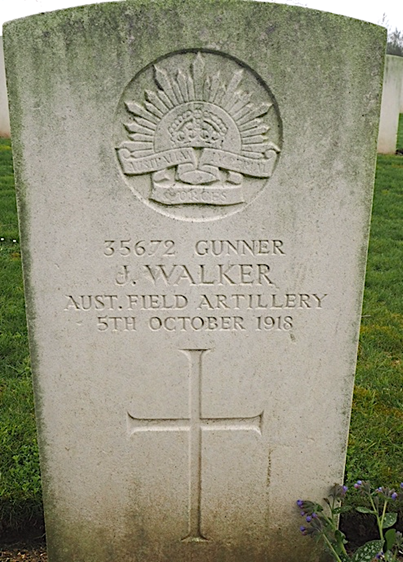
John Douglass Wall
Private, No. 783
30th Battalion, 8th Infantry Brigade, 5th Australian Division
Killed in action 20 July 1916, Fromelles, France
No known grave. Commemorated at V.C. Corner Australian Cemetery and Memorial, Fromelles, France
John (Jack) Douglass Wall was born in 1896, one of nine children of James and Avelyn Wall. John attended St Ignatius’ College, Riverview, and enlisted in 1915 while working at a real estate agency. John gave his father as his next of kin and his address as ‘Wyamgree’, 4 Wolseley Street, Drummoyne. Assigned to the newly established 30th Battalion in the equally new 8th Brigade, John arrived at the front lines in July 1916, and joined the 5th Division’s diversionary attack on German trenches at Fromelles. Although the 30th Battalion was assigned to support the attacking Battalions of the 8th Brigade by carrying supplies and digging trenches, its elements quickly became absorbed into the desperate fighting that followed. John’s remains were never located, and he is commemorated at the V.C. Corner Australian Cemetery and Memorial, Fromelles, France.
Studio portrait of John Douglas Wall

Stanley Watson
Private, No. 4791
20th Battalion, 5th Infantry Brigade, 2nd Australian Division
Killed in action 12 November 1916, Flers, France
Buried Warlencourt British Cemetery, France
Stanley Watson was born in 1894 in Newcastle upon Tyne in northeast England. An apprentice butcher by profession, he emigrated with his mother to Australia prior to the outbreak of the war. While working as a butcher in Drummoyne, Stanley enlisted in the AIF in November 1915 and was assigned to the 12th Reinforcements to the 20th Battalion. Stanley joined his battalion in early October 1916 and within a month, on the outskirts of Flers in France, was killed by a sniper. Stanley was buried by his comrades and his remains exhumed after the war and reburied in Warlencourt British Cemetery, France.
Close up of Private Stanley Watson taken from AWM ID No. H13922.

James Stuart Duncan Weir
Private, No. 2867
4th Battalion, 2nd Infantry Brigade, 1st Australian Division
Killed in action 26 July 1916, Pozieres, France
No known grave. Commemorated at Australian National Memorial, Villers-Bretonneux, France
James Stuart Duncan Weir was born in Balmain and was 20 years old at the date of enlistment in August 1915. Known by his middle name, Stuart was living at Bridge Street, Drummoyne. A butcher by profession, he gave on his attestation papers the details of his father, John Weir, as his next of kin. Stuart’s military career would be a brief one – he would be killed in his first action within four months of arriving in France, during the attack on the village of Pozières in July 1916. Although it is suggested in the war service records that he was buried in the vicinity of Pozières, he is officially recorded as having no known grave and is commemorated at the Australian National Memorial, Villers-Bretonneux, France.
AUSTRALIAN HEROES KILLED IN FRANCE. (1916, November 18). The Sydney Morning Herald (NSW: 1842-1954), p. 9. Retrieved January 27, 2023, from
http://nla.gov.au/nla.news-article15676072

Herbert John Wilder
Private, No.3003
58th Battalion, 15th Infantry Brigade, 5th Australian Division
Killed in action 25 September 1917, Polygon Wood, Belgium
No known grave. Commemorated the Ypres (Menin Gate) Memorial, Ypres, Belgium
Herbert John Wilder was born in 1882 in Scone, NSW. He married Annie Mulligan in 1909 and they had three children by the time that Herbert enlisted in the AIF in August 1916. At the time the family was living at 25 Cometrowe Street, Drummoyne. Herbert was assigned to the 58th Battalion which he joined in March 1917, seeing action at Bullecourt in May 1917 where he was wounded, and at Polygon Wood outside of Ypres in Belgium when he was killed during fighting on 25 September 1917. While it is believed that Herbert was buried close to where he fell, his grave was not located after the war. Herbert is commemorated on the Ypres (Menin Gate) Memorial, Ypres, Belgium.
Walter Burt Williamson
Private, No. 4897
53rd Battalion, 14th Infantry Brigade, 5th Australian Division
Killed in action, 19 July 1916, Fromelles, France
No known grave. Commemorated on V.C. Corner Australian Cemetery and Memorial, Fromelles, France
Walter Burt Williamson was born in Petersham in about 1884, one of six children of Mark and Minnie Williamson. The family appears to have a close connection with Drummoyne with the majority of the children recorded as having been born in the Drummoyne district. After attending St Joseph’s College, Hunters Hill and Hawkesbury Agricultural College, Walter married Caroline Fuggles in 1910, and they had their first and only child the next year. Walter enlisted in the AIF in August 1915 and was assigned to the newly established 53rd Battalion in Egypt and transferred to France in June 1916. The battalion’s first action was the 5th Division’s ill-fated attack on the German lines at Fromelles on 19 July 1916. Initially reported as missing, a Court of Inquiry a year later concluded that he had been killed in action. Walter’s remains were never recovered, and he has no known grave. He is commemorated at V.C. Corner Australian Cemetery and Memorial, Fromelles, France.
John Michael Joseph Wills
Private, No. 7099
13th Battalion, 4th Infantry Brigade, 4th Australian Division
Killed in action 8 August 1918, Morcourt, France
Buried Heath Cemetery, Harbonnières, France
He Gave His Life for King & Country His Loving Wife
John Michael Joseph Wills was born in about 1889, the eldest son of James and Jessie Wills. John married Opal Roslyn Wills (née Wynyard) in 1910 and they had three children. John worked for the Postmaster-General as a postman and gave as his address at time of enlistment as c/- Mrs Violet Norman of "Takapuna", Park Avenue, Drummoyne. John had more than six years military training prior to enlistment, and was assigned to various training depots in England, even serving a stint with the Provost Corps, before he finally joined his Battalion in April 1918 on the Western Front. He would see action in the Battle of Amiens and the attack on Morcourt as part of the Allies’ August offensive. John would be killed in action near Morcourt on 8 August 1918.
Photograph of the grave of John Wills at Heath Cemetery, Harbonnières.
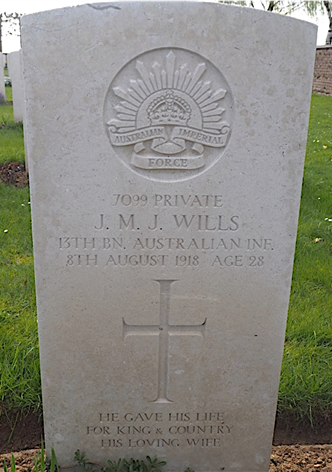
Colin Godfrey Wilson
Private, No. 1303
33rd Battalion, 9th Infantry Brigade, 3rd Australian Division
Killed in action 28 July 1918, Sailly Laurette, France
Buried Australian National Memorial, Villers-Bretonneux
"Have Mercy Upon Him Lord and Let Perpetual Light Shine Upon Him"
Colin Godfrey Wilson was born in Brisbane, Queensland and was 19 years old at the date of enlistment in February 1916. Educated at Moree Superior Public School and Christian Brothers, Paddington, he described his occupation as a ‘porter’ and gave his current address at time of enlistment care of the Imperial Hotel, Moree. Colin would see action on the Somme during the terrible winter of 1916–17, at Messines, Poelcappelle and Passchendaele in the Ypres sector in 1917, before returning to the Somme to assist in repelling the German offensive to Amiens in March 1918. During his period of active service, Colin would be wounded twice, before being killed while manning a Lewis gun in the front-line trench by a German shell in July 1918. Colin was killed instantly and was initially buried at Vaux-sur-Somme. His remains would ultimately be exhumed and reinterred at the Villers-Bretonneux Australian Memorial Cemetery in 1919.
Photograph of the headstone of the grave of Colin Wilson, Villers-Bretonneux Military Cemetery.
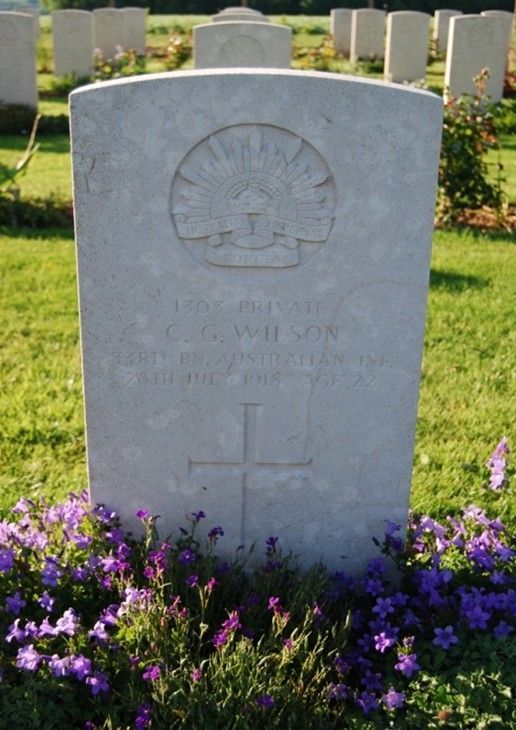
Charles Henry Young
Private, No. 6842
1st Battalion, 1st Infantry Brigade, 1st Australian Division
Died of illness, 7 February 1917, Wiltshire, England
Buried Durrington Cemetery, Wiltshire, England
Charles Henry Young was born in about 1887 in Balmain and enlisted in the AIF in October 1916 while working as a labourer. Charles’ military career was a brief one as within a month of arriving in England, and before he had joined his unit, he was admitted to hospital in Salisbury and died from bronchial pneumonia on 7 February 1917. Charles is buried at Durrington Cemetery, Wiltshire, England.


